
World-first circumnavigation
Around New Guinea by traditional canoe
Barrier Reef mystery wreck
On the trail of the Jardine Treasure
Maritime robots
The future of maritime technology


World-first circumnavigation
Around New Guinea by traditional canoe
Barrier Reef mystery wreck
On the trail of the Jardine Treasure
Maritime robots
The future of maritime technology
ONE OF MY FONDEST MEMORIES leading into the London Olympic Games was working on the design of a vast new gallery for the National Maritime Museum at Greenwich. The Sammy Ofer Wing was to be built right up against the boundary of Greenwich Park. Working with the architects CF Moeller, we had to find clever ways to seamlessly integrate this massive modern structure into a historic World Heritage listed royal park. One way was by creating a series of water features, rills and fountains all carefully positioned around the entrance. Although mainly ornamental, these quickly became one of the most used wetplay interactives in Greenwich Park. Now if you visit Greenwich in summer, you see them ‘adapted’ by families to float paper boats, launch pooh-sticks or simply splash about in. At the time this playful adaptation was largely a happy accident, but for me it’s a powerful reminder of the playfulness and creativity museums can inspire not just in children, but also in adults.
Since the early 1980s museums have developed particular expertise in designing play-centred environments that stimulate children’s imagination, creativity and dexterity. This year the Australian National Maritime Museum launched a new play centre, the Aquatic Imaginarium. The development, led by Annalice Creighton, the museum’s Education and Programs Coordinator, incorporated a range of play-centred activities for children up to 12 years and their families. What Annalice and her team created was an entire learning environment, weaving together a diatom disco sensory space and whimsical sculptures of marine animals, together with a series of carefully conceived and open-ended play activities. The Aquatic Imaginarium has been so successful that we are expanding the concept and bringing it back to Darling Harbour later this year.
But it’s not just children who enjoy playing in museums. This is borne out by responses to our recent visitor survey. When asked their main reason for visiting the Maritime Museum, over half of our adult respondents replied that it was to climb aboard HMAS Vampire, HMAS Onslow and our replica HMB Endeavour. These three ships are enormous interactive environments about which adults as well as children learn primarily through physical interactions – climbing up and down ladders, clambering through hatches, lying in bunks and hoisting sails. I contend that not only are these three ships the largest objects in our nation’s cultural collections, but they are also the most popular playgrounds for adults in Sydney!
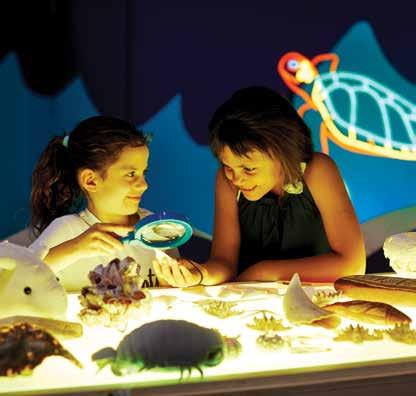
Children examine and touch specimens and artefacts in the Aquatic Imaginarium over the summer holidays. Image James Horan Photography
For more than 20 years I have developed play-centred galleries and learning environments at the Australian National Maritime Museum, Powerhouse Museum and Royal Museums Greenwich. In doing so, I have been guided by the work of the education psychologist Howard Gardner who, in his 1983 Frames of Mind study, put forward a list of multiple intelligences as a challenging alternative to rigid, traditional IQ tests. He proposed that humans possess eight distinct units of mental functioning. He labelled these units ‘intelligences’ and asserted that each has its own observable and measurable set of abilities. It was never Gardner’s intention to equate intelligence with play, but I believe he has given museums a wonderful design checklist. Today I continue to use this checklist whenever I approach the task of building a gallery, playground or education centre and always strive to ensure that it incorporates one or more experiences inspired by Gardner’s verbal, inter-personal, intrapersonal, logical, spatial, musical and bodily–kinaesthetic intelligences.
If, like me, you are passionate about play-centred learning in museums, can I recommend the MuseumNext conference. MuseumNext is a major conference series that explores the future of museums and takes place in Europe, North America and now Australia. On 1 and 2 April 2019, the conference is being held here at the Australian National Maritime Museum (see article on page 77) and will feature speakers from around the world discussing the future of play and creativity in our museums.
Kevin Sumption psm Director and CEO Australian National MaritimeMuseum
Acknowledgment of country
The Australian National Maritime Museum acknowledges the Gadigal people of the Eora nation as the traditional custodians of the bamal (earth) and badu (waters) on which we work.
We also acknowledge all traditional custodians of the land and waters throughout Australia and pay our respects to them and their cultures, and to elders past and present.
The words bamal and badu are spoken in the Sydney region’s Eora language. Supplied courtesy of the Metropolitan Local Aboriginal Land Council.
Cultural warning
People of Aboriginal and Torres Strait Islander descent should be aware that Signals may contain names, images, video, voices, objects and works of people who are deceased. Signals may also contain links to sites that may use content of Aboriginal and Torres Strait Island people now deceased.
Cover Downward Force on Upward Moving Objects (detail), Wang Luyan, 2018 – one of the works that features in our current exhibition On Sharks & Humanity. Image Samuel Carslake
Number 126
to May
2 A maritime Mordor
The first circumnavigation of New Guinea by traditional sailing canoe
10 $7,000 maritime history prizes
Nominations now open for biennial book and community history prizes
12 Towards 2020 and beyond Cook
Three events coincide to prompt debates about our national identity
18 Black reefs and the ‘Jardine Treasure’
The Boot Reef Project and a mystery shipwreck
26 Remembering AE1’s lone New Zealander
The short life of Able Seaman John ‘Rosy’ Reardon
30 The colonial sloop Norfolk
A question of tonnage – did Matthew Flinders get it wrong?
36 The rising tide of maritime robots
Autonomous vehicles revolutionise maritime industries and research
38 The Seabin Project
An Australian innovation helps to clean up our oceans
40 Ida – for love of a classic yacht
A century-old yacht: restored, researched and returned to its birthplace
46 Reconciliation in action
Respecting and involving Indigenous communities in everything we do
48 The Australian Maritime Museums Council
Connecting, discussing and sharing maritime heritage
52 Message to Members and museum events for autumn
Your calendar of activities, talks, tours and excursions afloat
58 Member profile
Welcoming Dawn Gardiner to our new Captain’s Circle
60 Autumn exhibitions
Wildlife Photographer of the Year ; The daring ship: HMAS Voyager and more
64 Foundation
Telling the stories of a nation of migrants
66 Collections
A tea tray memorialises the death of Captain Cook
70 Welcome Wall
A teenage Italian proxy bride finds a new life in Australia
74 Readings
Finding Pax by Kaci Cronkhite
76 Currents
New honourees to the Australian Sailing Hall of Fame; MuseumNext conference
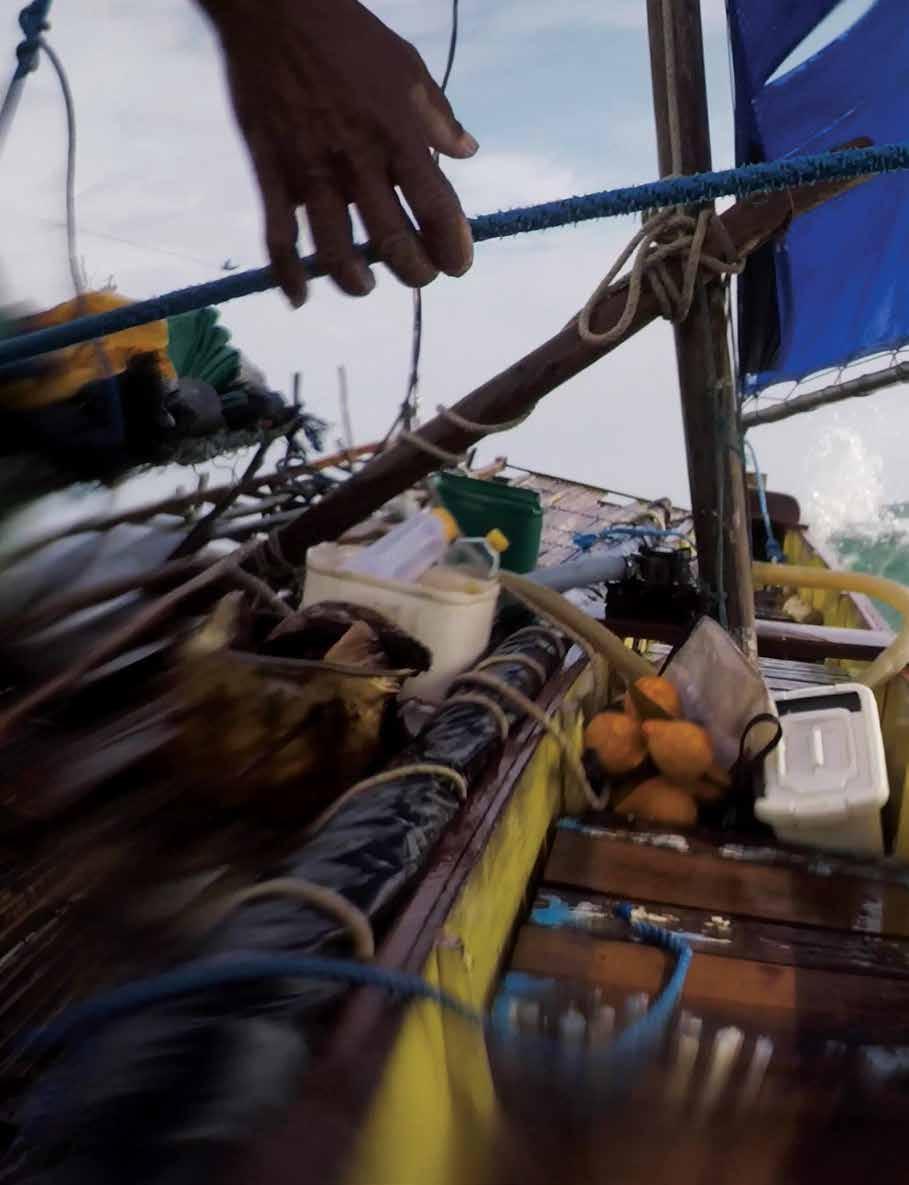
It was intense sailing and several surprise waves just appeared out of nowhere and crashed over our outrigger
Waves in the Gulf of Papua about to break over the outrigger. All images © Thor F Jensen
On 30 August 2016, Danish filmmaker Thor F Jensen and three Papua New Guinean master sailors embarked on the world’s first circumnavigation of the island of New Guinea in a traditional sailing canoe. Their modern-day odyssey covered 6,300 kilometres, took almost 14 months, and faced relentless monsoon winds, dangerous seas, pirates and crocodiles. This is an edited excerpt from Thor F Jensen’s forthcoming book and film of the journey, Salt Water and Spear Tips.
Trying to navigate those breakers in the dimming light at this time of year would be virtual suicide
01
Justin John steering with the yabby yabby (rudder) and Sanakoli John working the mansiti (mainsheet).
02
When the crew first called into Apiope the villagers hid themselves in their huts, but soon the sailors were welcomed.


We were about to sail the most dangerous stretch of coast in the entire Gulf of Papua
THE GULF OF PAPUA WAS A FRIGHTFUL SIGHT, and even more daunting was that people actually ran small dinghies through this maritime Mordor of two-metre-high brown, barrelling destruction. Now I was on one of those vulnerable fibreglass craft, speeding between long rows of breakers. The dinghy driver would see the forming pattern ahead and steer out of one churning boil after another. Every time we made a last-minute escape, he would widen his eyes and exclaim, ‘Zazazazahhhh! ’ There was no doubt that we had a skilled captain and that he was in that perfect ‘sweet spot’, where your skills are challenged to the extreme but you prevail – although I didn’t know how long this would last, because he and his mates were hitting the ‘jungle juice’ (home brew) pretty hard.
When I arrived in the village of Apiope with a bag of sparse provisions, I was greeted by my crew, Milne Bay master sailors Sanakoli and Justin John. Together with the brothers, I was attempting a great world record: the first circumnavigation of the island of New Guinea in a traditional sailing canoe –a 6,300-kilometre odyssey that began on 30 August 2016 from the Tawali Resort in Milne Bay Province. I was worried how they were feeling about taking our chances in the Gulf, so I was glad that I could at least deliver a positive weather report promising fair winds and lower waves for the next couple of days. My companions were used to navigating through their home islands by sight and what I can best describe as instinct. During our last 12 months of coastal travel, we had combined their sense of the sea with charts, a compass and a GPS. I unfolded the map and pointed to the route ahead: ‘There are some difficult sections by the river mouths.’ Sanakoli replied, ‘We take the route, easy-easy, first Vailala, next day we look for the weather, if good we go to K-town [Kerema].’
Early the following morning, we tied everything down on the canoe. Our vessel, named Tawali Pasana (meaning ‘reef flower’ in the Tawal language) was basically a nine-metre-long dug-out tree trunk with a 20-centimetre strake on each side, supported by a long outrigger pontoon in lightwood. The sailau, as this type of canoe is called in Milne Bay, had been built four years previously on Basilaki Island off the eastern tip of mainland Papua New Guinea and used for shark fishing and transport. It was a traditional design with some modern materials. The sail was sewn of plastic sheets, copper nails were used in the strake and the lashings on the outrigger were tied with 50-pound fishing line.
A curious nod to history was the sealant between the strake and the hull. Instead of the traditional glue boiled from bark, our canoe was puttied with tar boiled from a World War II oil drum that Justin and Sanakoli’s father had salvaged from the bottom of the sea. Finally, our bow had a feature inspired by the outer islands – a board covering the top of the bow to avoid swamping when digging into waves. This combination of traditional and outside influences made Tawali Pasana an apt metaphor of contemporary New Guinea. The wind and sea looked promising, but we were vigilant all the same – we were about to sail the most dangerous stretch of coast in the entire Gulf of Papua.
The first difficulty was to get out from the beach. Then, we had to sail east passing the two conjoining river mouths by Apiope (where a dinghy had capsized two weeks prior to our arrival). Unlike a dinghy, Tawali Pasana couldn’t turn on a plate; we had to use the wind and yaya-towa (meaning ‘come about’) every time we needed to change direction. The sailors would have to calculate our course with reference to the lines of breaking swell ahead and thus avoid dangerous sections of canoefloundering waves. If anyone could pull this off it would be Justin and Sanakoli John. Soon one geyser after another exploded off our bow. Tawali Pasana resolutely dug through the growing breakers.
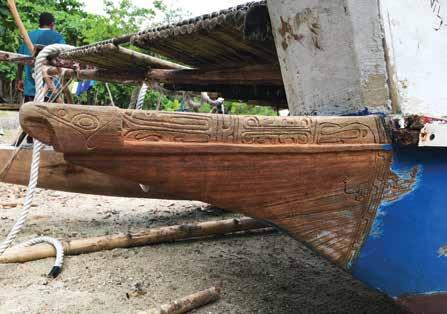
The sheet was tightened then slackened by Sanakoli as Justin stood with stoic alertness by the yabby-yabby (a wide-bladed paddle used as rudder) and cautiously navigated us out through the maze of deceiving conditions. I was fully occupied emptying our ever-filling hull with our bailer (a helmet) and recording the excitement with a GoPro camera. The canoe then turned east and sailed through the unruly swells of the river mouth. This was a most dangerous and delicate manoeuvre. If we went too close to land, the brown estuarine turmoil would devour us. If we went too far out, the incoming ocean swells would break over us. It was intense sailing and several surprise waves just appeared out of nowhere and crashed over our outrigger. After what was the longest half hour of my life, we were past the river mouths and steering towards Vailala.
Our risky exit was celebrated with sak sak (sago) and dirty watar (cola cordial). I warmly complimented my companions. The plan now was to sleep in Vailala, a village beside a river where the brothers had family. When we reached the estuary at 1.30 pm, it became evident that going inside the sandbank leading to the river would be too difficult – we needed protected waters to land the canoe. ‘How far to K-town?’ Sanakoli asked. I looked at my notes and said hopefully, ‘I think we can make it before dark.’
Five hours later, we approached Kerema, the capital of the Gulf area, which is a large bay almost entirely encircled by mountains. We could see the lights of the town being turned on as we approached the long white rows of inshore foam that were reflecting the rapidly receding rays of the day. As we neared the entrance, the waves grew – as did our anxieties. ‘These waves are too much, nowhere to go in,’ Sanakoli said, looking concerned. Trying to navigate those breakers in the dimming light at this time of year would be virtual suicide. There was little we could do except go back out to sea and take our chances overnight in the Gulf, hoping that the wind wouldn’t pick up – and that we didn’t disturb the legendary giant stingray the locals had warned us about.
Clouds of hypnotic marine
shimmered in our wake, lighting up the hull
01
02
This was the beginning of a mysterious night. It was a new moon so there was little light; instead, the mountains began to spit winds at us in strange gusts. We came dangerously close to two fishing trawlers who didn’t seem to notice our lantern or heed my calls on the VHF radio as they hummed past us. The wind then became steady and Tawali Pasana shot up along the undefined coast, dodging a breaking reef – again, at the last minute. A strange cold rain began to fall in sheets and as it passed, clouds of hypnotic marine bioluminescence shimmered in our wake, lighting up the hull. Then the wind suddenly subsided and Justin handed me the sheet and went instantly to sleep in the front of the canoe.
It was long past midnight, but well before dawn. Sanakoli was sitting by the yabby yabby, nodding off. Then I noticed someone cooking on the outrigger platform. It was an old lady. She seemed familiar – it was the same ghostly old woman I had previously seen when we were sailing off Um Island, Sorong, West Papua. I felt that having a good meal was just what we needed. I could feel the warm fire. Then I snapped out of it, as if waking from a dream. I turned my headlight onto the platform; there was no one there. As morning came, we were bobbing through a clear turquoise sea and the land looked different. The Fellowship of the Tawali Pasana had made it through the mighty Gulf of Papua – and during the treacherous south-easterlies. Perhaps the spirit mothers really were looking after us. Of that, Sanakoli and Justin had no doubt.

My companions were used to navigating through their home islands by sight and what I can best describe as instinct
01
Completion of the
02
Hand-drawn map by Thor F Jensen.

The Fellowship of the Tawali Pasana had made it through the mighty Gulf of Papua

On 4 October 2017, we arrived at Inuoro Island and thus we had crossed the border into Milne Bay Province, although the sailors were of the opinion that Milne Bay first started on the Suau coast. As we approached the beach, the wind disappeared –we were in lee of the island, almost touching the coral beach. I was standing ready to jump ashore when a strong current suddenly took our bow and started sweeping us along the beach toward a section of breakers. ‘Damn,’ I thought. But a local kid had seen it all and reached his hands out. I threw the line and he tied us off to a coral head. Yet another close call.
The next morning, we sailed out. The weather forecast didn’t look that good, although we thought we could manage. Leaving Inouro Island went well as the reef protected our launch from the incoming waves but, as soon as we were free, the waves grew, although at that stage, everything was still manageable. ‘Kisoo,’ Justin suddenly yelled. Our nylon fishing line tightened. I untied the string from the mast just in time for a fish to make a violent jerk that burned my hands. I almost lost the reel. ‘Ha ha, that is the pain of the fisherman,’ Justin mused. After some minutes, and an explosion of adrenaline, I heaved in a one-metre-long mackerel. ‘You watch the teeth, they are like razors,’ Sanakoli warned.
The big fish was thrusting violently. Sanakoli pulled the line and, as the spear-like head came out of the hull, I dispatched it with two sharp blows to the head using a piece of firewood. ‘Ho hoo,’ Sanakoli yelled, ‘Now we are home. That’s how we fish in Milne Bay Province.’ Justin joined in. ‘Gulf nothing. Central Province, small fish. Milne Bay, we catch big fish.’ We were all excited but the joyous hype soon evaporated. As I scooped the blood off the deck, the wind started to gust so we made a jaya-towa and went inwards. Here, a sandbank created a nasty chop, so we went outwards again where the waves had grown even bigger. There was nothing to do but diligently jig-jag (tack) while trying to navigate between the two extremes.
We suddenly found ourselves in a very bad situation. The waves were tall and short and angry. The two brothers did their best but the sea was breaking on the outrigger with a force that rattled the whole canoe. We heard a flapping noise. The black plastic had given in and a two-metre-long slit appeared in the sail. There was no time to spend on this as swells broke on the bow and our water containers started to float in the hull. I dumped the bailer and got to our bilge pump. I was getting a now familiar dire feeling and started to think, ‘How much pounding can our Tawali Pasana take?’ The dreadful answer came soon enough. Justin yelled in the Bwanabwana language. Sanakoli turned his head and looked shocked. I followed his red eyes. Disaster! Two poles had already broken off from the outrigger. I looked around. We were surrounded by high seas, six nautical miles from land and the same distance to our next destination of Bona Bona. My heart sank as I instantly recalled Bula, where we had refitted the outrigger … and Justin’s cautionary words – ‘You tie them strong, if one break, all soon break. And we sink.’
Shortly after this episode, Thor F Jensen, Justin John and Sanakoli John completed their historic voyage, which generated enormous media coverage and inspired the young people of New Guinea to celebrate their extraordinary seafaring culture.
Thor F Jensen is a Danish adventurer and award-winning filmmaker. To register for an author-signed first edition of his book, please visit saltwaterandspeartips.com
Thor F Jensen wishes to thank culturalconsulting.com.au and Sophia Pascoe for editorial assistance.
Writers, publishers and readers of maritime history are invited to nominate works for maritime history prizes totalling $7,000, sponsored jointly by the Australian Association for Maritime History and the Australian National Maritime Museum. Nominations for the 2019 round close on 31 July 2019.
EVERY TWO YEARS, the Australian National Maritime Museum and the Australian Association for Maritime History sponsor two prizes: the Frank Broeze Memorial Maritime History Book Prize and the Australian Community Maritime History Prize. Both reflect the wish of the sponsoring organisations to promote a broad view of maritime history that demonstrates how the sea and maritime influences have been more central to the shaping of Australia, its people and its culture than has commonly been believed.
The major prize is named in honour of the late Professor Frank Broeze (1945–2001) of the University of Western Australia, who has been called the pre-eminent maritime historian of his generation. Professor Broeze was a founding member of the Australian Association for Maritime History and inaugural editor of its scholarly journal The Great Circle, and introduced Australia’s first university course on maritime history. He wrote many works on Australian maritime history, including the landmark Island Nation (1997), helping to redefine the field in broader terms than ships, sailors and sea power. He reached into economic, business, social and urban histories to make maritime history truly multidisciplinary.
This will be the eighth joint prize for a maritime history book awarded by the two organisations, and the third community maritime history prize.
The 2019 Frank Broeze Memorial Maritime History Book Prize of $5,000
To be awarded for a non-fiction book treating any aspect of maritime history relating to or affecting Australia, written or co-authored by an Australian citizen or permanent resident, and published between 1 January 2017 and 31 December 2018. The book should be published in Australia, although titles written by Australian authors but published overseas may be considered at the discretion of the judges. The prize is open to Australian authors or co-authors of a book-length monograph or compilation of their own works.
Fictional works, edited collections of essays by multiple contributors, second editions and translations of another writer’s work are not eligible.
The 2019 Australian Community Maritime History Prize of $2,000
To be awarded to a regional or local museum or historical society for a publication (book, booklet, educational resource kit, DVD or other print or digital media, including websites, databases and oral histories) relating to an aspect of maritime history of that region or community, and published between 1 January 2017 and 31 December 2018. The winner will also receive a year’s subscription to the Australian Association for Maritime History and a year’s subscription to the Australian National Maritime Museum’s journal Signals
Publications by state-run organisations, physical exhibitions and periodicals such as journals are not eligible.
The two biennial prizes reflect the wish of the sponsoring organisations to promote a broad view of maritime history
to nominate
To nominate for the Frank Broeze Memorial Maritime History Book Prize, send one copy of the publication to the address below. Copies of any published reviews may also be included.
To nominate for the Australian Community Maritime History Prize, send a physical copy of print publications or DVDs.
For digital publications such as websites, databases, online exhibitions or apps, nominations must include 250–300 words explaining the vision and objectives of the digital media, plus data indicating its success. For websites and databases, also provide the URL or download details; for an app or other digital media, submit it on a USB. Copies of any published reviews may also be included.
Multiple nominations may be made, but each must be for one category only.
Nominations for both prizes close on 31 July 2019. They should be emailed to publications@sea.museum or posted to:
Janine Flew
Publications coordinator
Australian National Maritime Museum Wharf 7, 58 Pirrama Road
Pyrmont NSW 2009
Judging process
Following an initial assessment of nominations, shortlisted authors or publishers will be invited to submit a further two copies of their publication. These will be judged by a committee of three prominent judges from the maritime history community.
The judges’ decision will be final and no correspondence will be entered into.
The prize will be announced and awarded at a time and venue to be advised.
Judging of the 2017 awards
We regret that the judging of the 2017 awards has been unavoidably delayed. It is currently under way, however, and an announcement will be made as soon as possible.

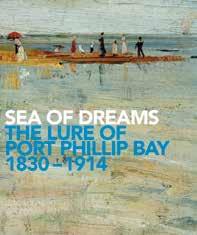
Previous prize winners: In All
Respects Ready by David Stevens, winner of the 2015 Frank Broeze Book Prize, and Sea of Dreams , winner of the 2013 Australian Community Maritime History Prize.It is clear that Australian society is undergoing a sea change, balanced uncertainly between the desire to honour the past but mindful of the need to embrace the future
In a multicultural country increasingly aware of the history and cultures of its First Peoples, how relevant is Australia’s colonial (British) history? Head of Research Dr Nigel Erskine profiles three recent events and how they relate to notions of our national identity.
THE COINCIDENCE OF THREE IMPORTANT EVENTS in January this year provided a rare moment to reflect on Australian history and its ongoing relevance for Australians today. The first of these is Australia Day, which, since 1988 – the bicentenary of European settlement – has become a major public holiday and national anniversary. It is celebrated on 26 January, the date on which the colony of New South Wales was officially established with the raising of the Union flag in Sydney Cove in 1788.
Before 1988, 26 January tended to be looked at as a singularly New South Wales anniversary, leaving the other six states and territories to celebrate anniversaries relating to their own distinct colonial foundations. The initial British settlement in Australia was confined to the east coast of the continent, the part claimed by Lieutenant James Cook in 1770 during his survey of the east coast on board the bark Endeavour. By 1787, the territory of New South Wales had grown considerably and extended from 10 degrees 27 minutes south (Cape York) to 43 degrees 39 minutes south (South Cape) to 153 degrees east (halfway across South Australia). It also included all the adjacent Pacific islands within these latitudes.
The second event of note that occurred in January was the discovery of the grave of Captain Matthew Flinders in London. It was announced on 25 January, only a day before the anniversary of the foundation of British settlement in Australia. The timing could not have better, and the event was major news across Australian media.
Of all the early British naval figures who explored Australia’s coasts after Cook, Matthew Flinders looms largest. He sailed to New South Wales in 1795 aboard HMS Reliance, bringing the new Governor, John Hunter, to the colony. Also aboard Reliance was surgeon George Bass. Over the next five years Bass and Flinders completed a number of small-boat expeditions, including the circumnavigation of Van Diemen’s Land (now Tasmania) in 1798. As a result of this work Flinders was promoted lieutenant and in 1800 returned to England with an ambitious plan to survey the entire coast of Australia. At that time, most of Australia’s south coast remained unexplored by Europeans. Large sections of the west and north coasts had been mapped by the Dutch, and Cook had mapped most of the east coast, but no single survey of the entire coast existed. The Admiralty agreed to place Flinders in command of a ship. They provided the armed vessel Xenophon, refitted it for a voyage of discovery and renamed it, appropriately, HMS Investigator
01
Map from 1787. New South Wales is marked with places named by Cook; New Holland, as the rest of the continent was then known, bears names given by Dutch explorers the previous century. Matthew Flinders was yet to circumnavigate Van Diemen’s Land (Tasmania) and determine that it was an island. British colonial expansion and gradual claim to the entire continent progressed throughout the 19th century. ANMM Collection 00000368
02
Colonial Wallpapers: Pacific Encounters , Helen Tiernan, 2017. Based on the conventions and elements of early European sea charts, this work takes as its starting point the panoramic French wallpaper design produced in 1805, Les Sauvages de la Mer Pacifique, which illustrated Captain James Cook’s voyages around the Pacific. It combines images from these voyages with the mythical, romantic and ridiculous to question the depiction of the Pacific that explorers brought back to Europe during the ‘Age of Discovery’. ANMM Collection 00055114 Funded by ANM Foundation. © Helen S Tiernan

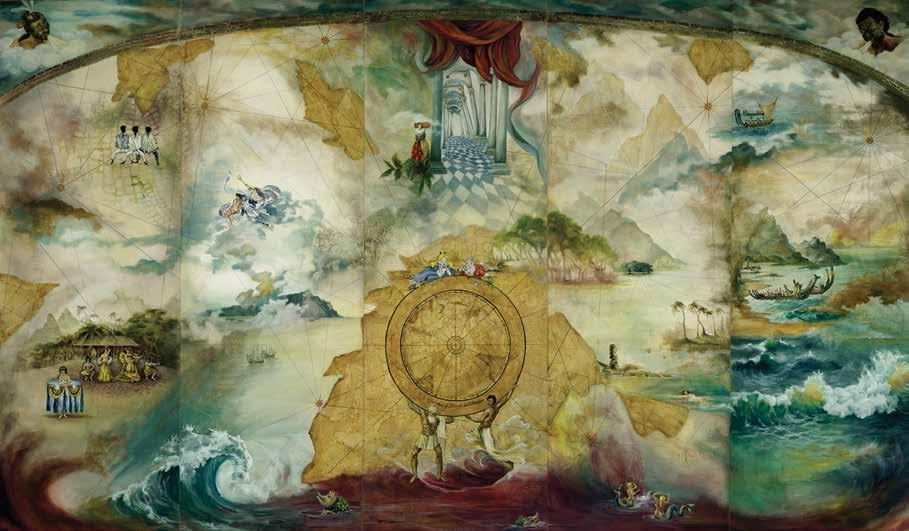
Of all the early British naval figures who explored Australia’s coasts after Cook, Matthew Flinders looms largest
01
The breastplate found on Flinders’ coffin. It reads simply ‘Capt n Matthew Flinders RN Died 19 July 1814 Aged 40 Years’. Image courtesy HS2
02
As part of preparatory works for the high-speed London to Birmingham rail link, archaeologists exhumed thousands of graves, among them that of Matthew Flinders, at London’s Euston railway station. Euston Station opened in 1837, and when it was expanded 50 years later, platforms were built over the adjacent St James’s Church burial ground, where Flinders had been buried in 1814. Image courtesy HS2
Despite its great achievements surveying on the south and east coasts of Australia, the expedition was severely hampered by the poor and worsening condition of the Investigator By the time Flinders reached the Gulf of Carpentaria in 1803, he decided the ship was too unseaworthy to continue. Flinders and Investigator ’s crew survived the counter-clockwise voyage around Australia to return to Sydney, but unfortunately were wrecked on an uncharted reef in the Coral Sea only a few weeks later, aboard HMS Porpoise on the passage home to England. Flinders later wrote an account of this journey and his subsequent imprisonment on Mauritius in A Voyage to Terra Australis. He died, aged 40, the day after it was published.
The third event that occurred in January was the Prime Minister of Australia’s announcement of $48.7 million dollars of financial support to mark the 250th anniversary of Captain James Cook’s first voyage to Australia and the Pacific. Prime Minister Scott Morrison stated: ‘That voyage is the reason Australia is what it is today and it’s important we take the opportunity to reflect on it.’
The announcement provoked an immediate social media deluge of varying comments: outright support for the initiative, criticism at the ‘waste of taxpayer money’, outrage at the inappropriateness of funding an anniversary regarded by many Indigenous Australians as the beginning of the end of their culture, and the question ‘Who was Captain Cook’?
Like all societies, Australian society is complex and dynamic, continually changing in response to political, cultural and financial influences that affect the way Australians view our history, and our present and future place in the world.

In 1788, when the colony of New South Wales was formed by just over 1,000 convicts, guards, and administrators on the other side of the world from Europe, it was totally dependent on Britain for supplies, the vast majority of the new arrivals were British, and Captain Cook had been dead less than ten years. Locally, around the new settlement in Sydney, the arrival of Europeans had a devastating impact on the traditional inhabitants, with the introduction of smallpox estimated to have killed at least 50 per cent of those living around Sydney Harbour.
From about 1815 the European population of Australia grew rapidly and by 1820 numbered over 33,000. In each successive decade it continued to more than double, so that by 1850 it exceeded 400,000.
Throughout its colonial period (1788–1901) Australia depended on Britain for its security. It established legal and political systems that mirrored those in Britain, and in 1901, when the Australian colonies voted for independence from Britain, they did so in the understanding that Australia would continue to pay allegiance to the British monarchy through the office of the Governor General of Australia.

The real measure of the success or failure of the 2020 commemorations will be the overall response of Australians to this latest anniversary
01 Australia Day protest march in Melbourne. In recent years Australia Day celebrations have increasingly polarised the population and seen calls to either scrap the national foundation-day holiday or change its date. Image Shutterstock.com
02
Group of male migrants on the deck of MV Napoli, 1951. Part of a collection of items donated by Davide Ellero, who migrated from Italy to Australia in 1951 on board Napoli to work on the Snowy Mountains Hydro Electric Scheme. ANMM Collection 00003536

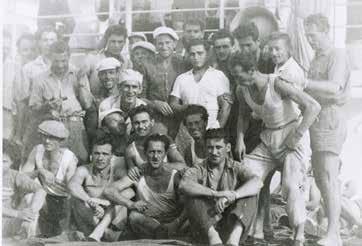
Australia’s loyalty to Britain was beyond question during the First World War, during the course of which more than 60,000 Australians were killed and 156,000 wounded or taken prisoner. For Australia, with a population of less than five million at the time, the impact on society was profound and the legacy of that sacrifice has become an integral thread of our national identity.
A critical turning point for Australia in its international relations came with the entry of the USA into the Second World War in 1941. The fall of ‘Fortress Singapore’ in 1942 demonstrated clearly that Britain was unable to protect its interests in the Indo-Pacific, heralding a new era when Australia increasingly turned to the United States. In 1951, Australia signed the Australia, New Zealand and United States Security (ANZUS) Treaty, agreeing to co-operate with the USA in military matters. In the 68 years since, Australia has supported the United States in conflicts from South-east Asia to the Middle East.
In the post-war period Australia opened its doors to European migrants seeking to rebuild lives shattered by the war and between 1947 and 1970 more than three million people migrated to Australia – initially from northern European countries, later from southern and eastern Europe, and later still from the Middle East and Asia.
In the 12 months to June 2018, migrants from China and India represented the highest percentage of new migrants to Australia, followed by those from the United Kingdom, New Zealand, Nepal, Malaysia, Philippines, Vietnam and the United States.1
At 30 June 2017, people born in England continued to be the largest group of overseas-born residents (4.1 per cent of the total population) but had declined in the decade since 2007, when they represented 4.6 per cent of the Australian population. 2 That decline is expected to continue.
For Indigenous Australians, the pace of change in the postwar period has been much slower, with landmark moments including the right to vote (1962); the right to be included in census population figures (1967); the Mabo land-rights decision by the High Court of Australia (1992); and, in 2008, the apology to Indigenous Australians of the Stolen Generation by Prime Minister Kevin Rudd and the High Court’s Blue Mud Bay sea rights decision. However, while political change has been slow, Australian society more generally has developed a much greater awareness of Indigenous culture and its increasing visibility and incorporation into the national vision of Australia.
Reflecting back on the three events in January, in light of shifting attitudes – our increasing detachment from Britain and declining migration from the UK to Australia, our national embrace of multiculturalism, and our growing desire for greater Indigenous inclusion – it is clear that Australian society is undergoing a sea change, balanced uncertainly between the desire to honour the past but mindful of the need to embrace the future.
Captain Cook’s contact with Australia was limited to the east coast, but for the purposes of marking the milestone 250th anniversary nationally, the Australian government has committed funds for the replica of Cook’s ship Endeavour to circumnavigate the entire country. It anticipates that the vessel’s visits to each state and territory will reinforce the national significance of Cook’s voyage as the event that led to the foundation of European settlement in Australia. However, irrespective of political will and government support for the 2020 anniversary, the real measure of the success or failure of the 2020 commemorations will be the overall response of Australians to this latest anniversary.
Australia in 2019 is a very different society to that which existed at the time of the bicentenary more than 30 years ago, with many people now calling for events that are more broadly inclusive and relevant to a greater cross-section of modern Australian society. James Cook, Arthur Phillip and Matthew Flinders will always have a place in Australian history, but Australians’ responses to the 2020 anniversary will play a major role in deciding how we honour our British heritage in years to come.
1 Australian Demographic Statistics, June 2018, Australian Bureau of Statistics 3101.0
2 Australia’s Population by Country of Birth, ABS 3412.0 Migration, Australia 2016–17
Boot Reef is a perfect ship trap – difficult to see, imperfectly charted and lying across one of the main entrances to Torres Strait
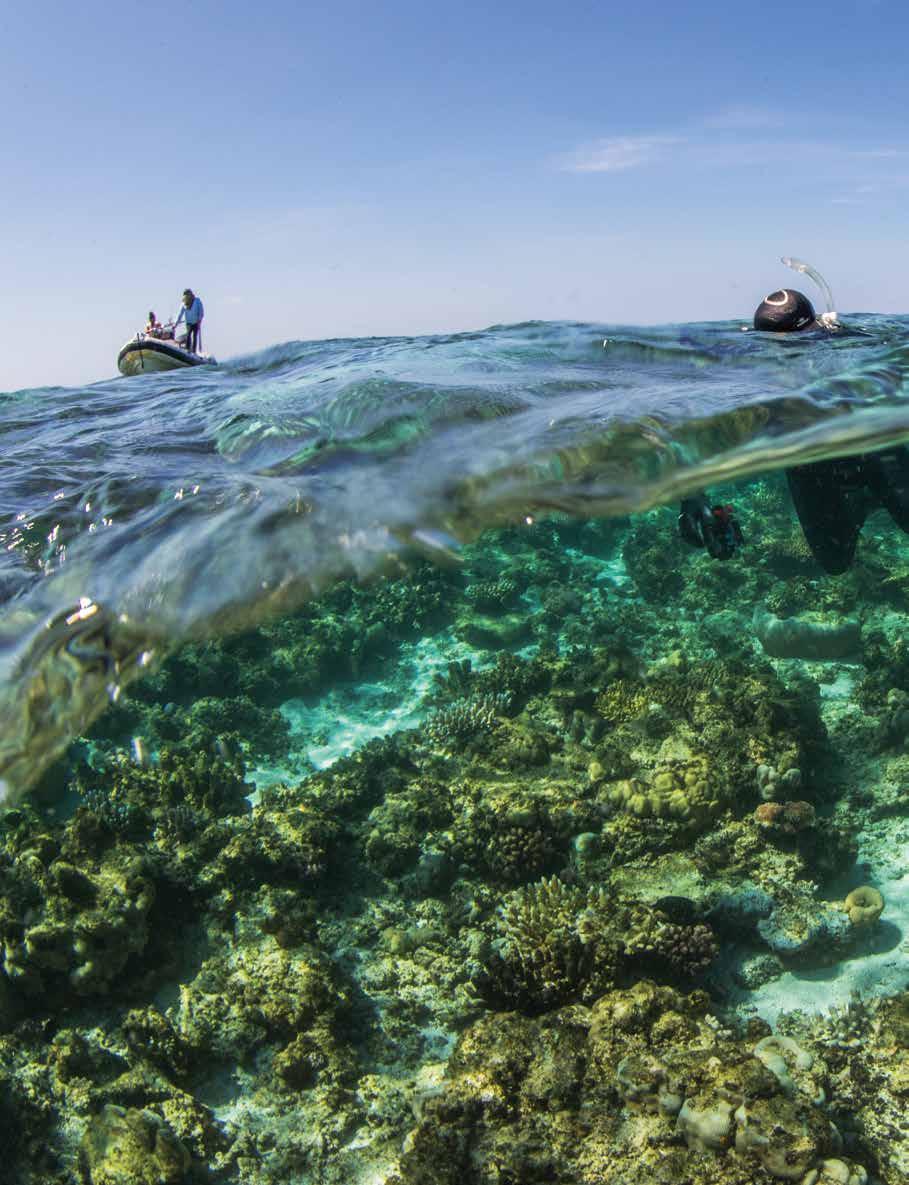

In December 2018, a team from the Silentworld Foundation and the Australian National Maritime Museum located a mystery shipwreck at Boot Reef off Australia’s far north-east coast. Archival research narrowed its possible identity to one of a small handful of wrecks from the early 19th century – foremost among them a site first reported in 1891, which, according to legend, contained a hoard of silver coins that came to be known as the ‘Jardine Treasure’. Authors Kieran Hosty, Dr James Hunter, Irini Malliaros and Paul Hundley were members of the expedition.
Irini Malliaros , Jacqui Mullen and Andrew White from Silentworld Foundation searching for ‘black reef’ on Boot Reef.BOOT REEF IS A DRYING REEF SYSTEM with two central lagoons. It is located 950 kilometres north of Cairns and some 30 nautical miles (56 kilometres) east of Yule Entrance at the extreme northern end of the Outer Great Barrier Reef.
The reef was given its European name by Lieutenant Matthew Flinders, who passed it in 1803 in the Colonial Government Schooner Cumberland on his way to England. Flinders had recently been rescued following the disastrous wrecking of HMS Porpoise and the merchant vessel Cato on Wreck Reefs in August 1803 (see Signals No 90).
In 1891, the crew of a bêche-de-mer (sea cucumber) fishing vessel, Lancashire Lass, located the remains of an early19th-century vessel on a remote coral reef in the northern approaches to Torres Strait. Lancashire Lass was captained by Sam Rowe and owned by Francis (Frank) Lascelles Jardine, a pastoralist and plantation owner from Somerset, Queensland. The shipwreck site was discovered while the crew of Lancashire Lass – which had been pushed across the reef top into an enclosed lagoon during a tropical storm – attempted to cut a channel through the reef to extract their vessel.
Rowe and his crew recovered numerous items from the wreck, including an ‘old-fashioned’ anchor, a small bronze gun and several thousand Spanish silver coins minted between 1713 and the mid-1820s. Six boxes of specie (coins) were later exported from Mer (Murray Island) on 22 May 1891 and sent to England via the steamer Tara. According to the Pall Mall Gazette of 5 January 1892, Tara later landed a large quantity of specie –which the newspaper called the ‘Torres Strait treasure’ –with a value of £6,600 (equivalent to at least $1 million today). Colonial newspapers such as The Sydney Morning Herald and the Morning Bulletin took up the story, and the legend of what became known as the ‘Jardine Treasure’ was born.1
In newspaper accounts reporting the discovery, Rowe and Jardine speculated that the large number of Spanish coins recovered from the wreck indicated it was a Spanish vessel – likely one that had left South America with the payroll for Spanish garrisons in either Mauritius or the Solomon Islands. For some unknown reason, the ship had ended up wrecked in the remote, far-northern Great Barrier Reef.
While willing to share some information, Rowe and Jardine were understandably reluctant to reveal the location of the shipwreck. They only stated that it was at ‘the very northern end’ or ‘the very outer edge’ of the Great Barrier Reef. The mystery of the wreck’s identity and location was compounded when Rowe was later murdered by the crew of his new lugger Wren in 1893. 2
That’s where the story of the Great Barrier Reef’s ‘mystery Spanish wreck’ might have ended, had the Australian National Maritime Museum and Silentworld Foundation not commenced a long-term research project in 2012 to investigate shipping routes through and around the Great Barrier Reef that connected 19th-century Australia with the rest of the world.
Colonial newspapers took up the story of the shipwreck haul, and the legend of what became known as the ‘Jardine Treasure’ was born
Descending off the western side of Boot Reef, expedition divers located a second long-shanked anchor in 39 metres of water. Pictured is Kieran Hosty (ANMM).
As part of their archival investigations into historic shipwrecks along these maritime routes, the team came across several mentions of the lost ‘Spanish shipwreck’ and uncovered a tantalising clue to its possible whereabouts in the collection of the Museum of Applied Arts and Sciences (Powerhouse Museum) in Sydney. Object N12662 is described as a ‘Coin, Spain, Ferdinand VII (1808–33). Dollar, Mexico Mint, 1817 found Boot Reef Torres Strait by Capt Rowe of Lancashire Lass.’ 3
The generous sponsorship of the Silentworld Foundation enabled the project team to survey Boot Reef last December to follow up these leads. Maritime archaeologists, researchers and staff from the Silentworld Foundation and maritime archaeologists from the Australian National Maritime Museum joined MV Silentworld at Thursday Island and commenced a 24-hour passage through the eastern Torres Strait and beyond the outer edge of the Great Barrier Reef to the remote atoll.
Upon arriving at Boot Reef, we were pleased (and somewhat amazed) to find near-perfect weather conditions; the sea was flat and glistening in the tropical sun, with only a slight swell barely breaking to indicate the edge of the reef. While pleasant, these conditions also highlighted what a perfect ship trap Boot Reef could be, as it was difficult to see, imperfectly charted and lying across one of the main entrances to Torres Strait.
Our search for an anchorage emphasised the hazards posed by Boot Reef during the 19th century. No shallow-water anchorages exist at Boot Reef because it is a seamount with near-vertical walls that rapidly rise from a depth of 1,500 metres to a narrow plateau less than 100 metres wide at 90 metres depth. From this point, the seabed again rises vertically to sea level. Armed only with a 50-fathom (90-metre) sounding lead and relatively inaccurate charts, 19th-century sailors would have been caught completely off guard if they encountered the reef at night or in dead-calm conditions.
With no anchorage available, we decided to anchor inside the lagoon of nearby Ashmore Reef (see Signals No 112) at night and make the 10-nautical-mile (16-kilometre) journey to Boot Reef each morning.
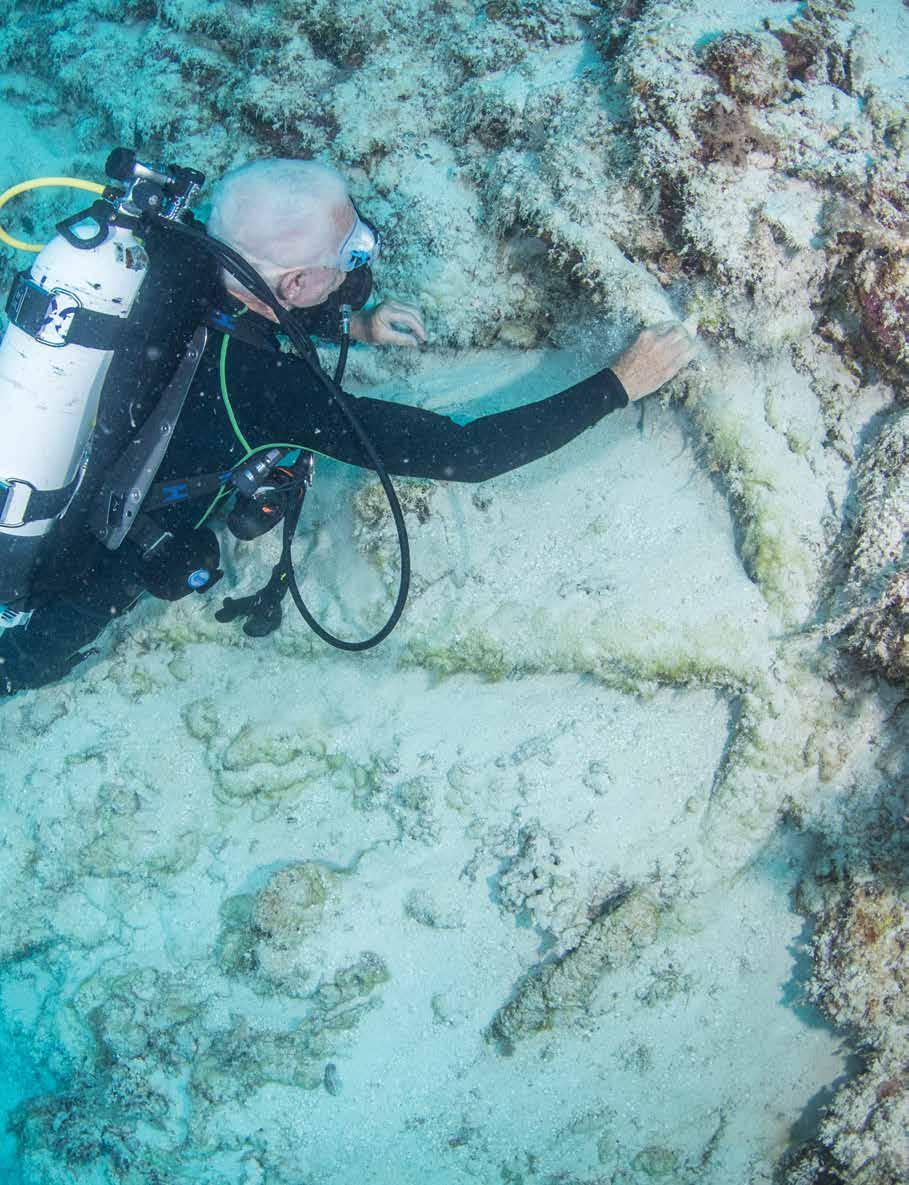
One of our first tasks was to circumnavigate Boot Reef in Blackwatch, the largest of Silentworld ’s three tenders. Because Boot Reef has a perimeter of more than 18 nautical miles (33 kilometres), this took several hours but allowed us to visually scan the reef top and look for signs of shipwrecks, including anchors, anchor chain and ballast mounds. It also facilitated collection of a series of GPS plots for the outer edge of the reef, which could be used for mapping once fieldwork was complete. Meanwhile, John Mullen of Silentworld Foundation managed to pilot the project’s remote-sensing survey vessel Maggie III over the reef top into the smaller of Boot Reef’s two completely enclosed lagoons. An investigation of the area located a few promising magnetic anomalies that could indicate the shipwreck discovered by Rowe.
With more fine weather the next day, the team continued the remote sensing survey along Boot Reef’s western side. The crew aboard Blackwatch towed the magnetometer along the outer and northern areas of the reef, while those on Maggie III surveyed the two sheltered, but surprisingly deep, lagoons. They also investigated areas on the reef flat which, in 2017, had been identified by maritime archaeologists from Silentworld Foundation and the Australian National Maritime Museum through satellite imagery as possible locations of a phenomenon known as ‘black reef’ – a consistent pattern of dark discolouration on the reef flat that correlated with the plotted locations of historic shipwreck sites.
Black reef is observed at sites of modern shipwreck or natural disaster.4 The relationship between black reef and shipwrecks has not been well studied, and research is ongoing. However, current and past investigations have noted a biological ‘phase shift’ in affected reefs, 5 in which a coral-dominated benthic ecosystem (inclusive of microalgae) is replaced by a predominantly (macro)algal one in response to stresses such as pollution via run-off, severe storm damage and shipwreck.
Black reef was not observed or recorded during the 2017 field season at Kenn Reefs, as it only became apparent during postfieldwork GIS (Geographic Information Systems) analysis.
The effects of historic shipwrecks on coral reefs are poorly understood. A primary aim of the Boot Reef project was to collect samples and acquire empirical data to contribute to a broader understanding of the relationship between black reef and historic shipwreck sites. Our research also hopes to quantify the potential of black reef to act as a predictive indicator for locating shipwrecks. The ability to review satellite imagery before undertaking fieldwork and to select areas of interest based on the phenomenon’s presence could potentially revolutionise the way sites are located on the Great Barrier Reef and in the Coral Sea.
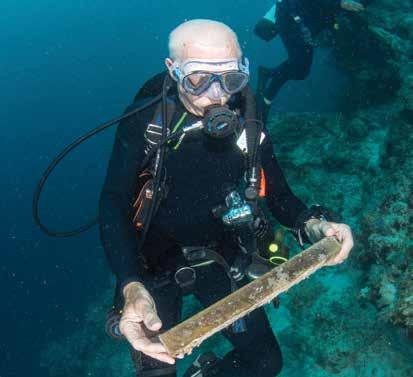
On the expedition’s fifth day, the magnetometer team found a series of significant magnetic anomalies on the western side of Boot Reef, along the upper edge of a near-vertical 90-metre drop-off. At the very same time, a team of snorkellers investigating a patch of black reef 50 metres to the east of these anomalies coincidentally located a run of anchor chain. Later in the day, the team aboard Maggie III found an early-19th-century old-pattern Admiralty long-shanked anchor lying on the reef top. The anchor appeared to be associated with, but was not physically connected to, the run of chain.
Aided by an aerial drone, additional magnetometer survey work and in-water searches, other shipwreck material was soon discovered, including copper-alloy hull fastenings, iron chain plates (used to attach the standing rigging to the hull of the ship) and a heavily eroded glass decklight.
The presence of an anchor and chain does not necessarily indicate a shipwreck site. It could instead mark where a vessel struck the reef and an anchor was used to ‘kedge’, or pull the hull into deeper water, before sailing away and leaving the anchor behind. However, the presence of the structural material strongly suggested that the vessel had endured significant damage and broke up as it was pushed across the reef flat.
With the anchor chain oriented almost directly east–west across the reef flat, the team investigated the area around either end in an effort to find the remains of the ship.
On the reef’s western side, the anchor chain was broken at the very edge of a 90-metre drop-off. Did this indicate the vessel had come from the east, struck the reef and bounced over the top, paying out its anchor and chain before either sailing away or sinking off the western edge of the reef? The only way to find out was to send teams of scuba divers down the drop-off to search for signs of the wreck.
01 Near the deep-water anchor, divers also discovered fragments of timber – an unusual find, given the warmth of the water and the presence of wood-eating marine borers. Pictured is Kieran Hosty (ANMM).
02
Libby Illidge (AIMS) and Jacqui Mullen (Silentworld) plotting the run of open-link anchor chain across the reef top. The anchor chain led the team to the drop-off and eventually the second anchor.
‘Black reef’ is a consistent pattern of dark discolouration on a reef flat that correlates with the plotted locations of historic shipwreck sites

The presence of an anchor and chain does not necessarily indicate a shipwreck site

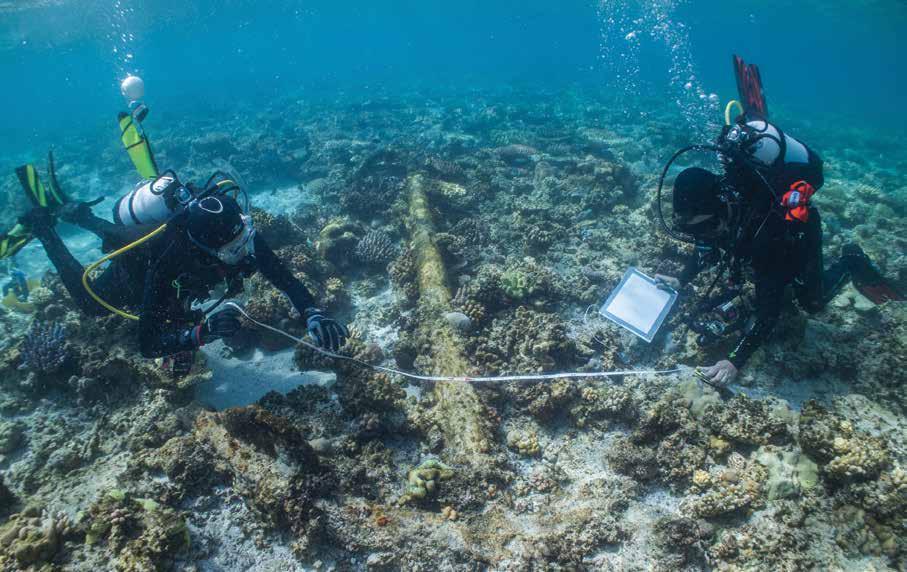
01 For their orientation and equipment check dive, the expedition divers revisited the site of the Comet (1829) on Ashmore Reef.
02 Irini Malliaros (Silentworld Foundation) and James Hunter (Australian National Maritime Museum) recording one of the old-pattern Admiralty long-shanked anchors found on Boot Reef.
Recovered from the wreck were several thousand Spanish silver coins minted between 1713 and the mid-1820s
Given the extreme water depth and Boot Reef’s isolation, this would be no ordinary reef dive. It required considerable planning and additional safety equipment, including emergency ‘bail-out’ air cylinders, in case the divers experienced equipment malfunction at depth.
Thanks to the reef’s excellent underwater visibility, the divers were able to scan the edge of the drop-off from sea level down to between 70 and 80 metres depth. They didn’t locate the shipwreck, but they did find a nearly identical Admiralty long-shanked anchor precariously perched on a coral ledge at 39 metres. Its presence, and the broken anchor chain on the reef flat almost directly above it, suggest that the vessel approached from the west and struck the reef’s western edge, where the crew dropped one of the anchors before running out its anchor chain. The vessel then appears to have slid eastward across the reef top, losing various structural components along the way.
A survey of the eastern side of Boot Reef located another scatter of shipwreck material in about two metres of water, including large iron keel bolts, mast rings, mast caps, lead shot, lead sounding weights and fragments of coal. At least two iron gudgeons (large hinges mounted on a ship’s stern upon which the rudder pivots) were also found, suggesting that the vessel’s stern section came to rest on the reef’s eastern edge. While the team did not find articulated timber hull components, evidence suggests that the Boot Reef shipwreck represents an early19th-century sailing vessel of some 200–300 tons that was copper sheathed and iron fastened.
Although the annotation associated with the silver coin in the Powerhouse Museum collection states that Rowe collected it from Boot Reef, the archaeological fieldwork conducted in December 2018 has cast some doubt on his assertions. While an early-19th-century shipwreck was located on the reef flat, the site does not resemble the description provided by Rowe in historic newspaper accounts. Also, archival research conducted by the team after the 2018 survey uncovered a 1911 statement by Frank Jardine that the shipwreck was located ‘in a lagoon of Portlock Reef’.6 This statement appears to contradict Rowe’s 1891 assertion that the wreck was located ‘on the extreme outer reef of the Great Barrier Reef Chain’. However, it is worth noting that Portlock Reef has historically been considered the extreme northern limit of the Great Barrier Reef.7
Whether or not the shipwreck found by Lancashire Lass was on Boot or Portlock Reef is a matter of conjecture, but there is reason to believe that it was the remnants of The Sun, an English-built, 185-ton brig that arrived in Hobart in early 1826 with a cargo of tea from China. It then sailed to Sydney, where its captain secured a cargo worth 30,000–40,000 Spanish dollars (equivalent to as much as AUD1.4 million today) in silver specie to deliver to Singapore. In December 1826, reports arrived in Sydney, via India, that The Sun had been wrecked on a remote coral reef near the northern entrance to Torres Strait. The entire crew appears to have survived and arrived at Mer after a twoday voyage in the ship’s boats. Tragically, 24 crewmen drowned when their boat capsized in the surf as they attempted to land.
Although it is difficult to confirm that Rowe and the Lancashire Lass crew found the wreck of The Sun, the type of coinage and its date range seem to favour the theory.
If the Boot Reef wreck is not the vessel located by Rowe, then archival research seems to indicate that it may be the Eliza (1815), Fame (1817), Henry (1825) or Venus (1826). These share many of the characteristics of the wreck found on Boot Reef, but only further research will be able to confirm its identity.
1 Most of the specie was sent by the Jardine family to England, but it is uncertain what happened to it.
2 The Brisbane Courier, 28 November 1893.
3 maas/291947, accessed 30 May 2018.
4 Hatcher, B, R Johannes and A Robinson (1989), ‘Review of the Research Relevant to the Conservation of Shallow Tropical Marine Ecosystems’, Oceanography and Marine Biology 27: 337–414.
5 Done, T J (1992), ‘Phase Shifts in Coral Reef Communities and Their Ecological Significance’, Hydrobiologia 247(1): 121–132.
6 The Brisbane Courier, 27 May 1911.
7 The Sydney Morning Herald, 5 May 1846.
Our work on Boot Reef would not have been possible without the generous support of our long-time research partner and major sponsor The Silentworld Foundation and the valuable assistance of John and Jacqui Mullen, Peter and Libby Illidge, Julia Sumerling, Andrew White, Captain Michael Gooding, Chris Ellis, Hamish Turvey, Shirley Puth, Victoria Miranda, Kamilah Fox, Maria Jose Gonzalez Rodri and Stephanie King.

Since the wreck site of HMAS AE1 was found in December 2017, the stories of many of its 35 crew have been highlighted in the press. One crewman, however, has been largely overlooked. The only member of the submarine’s complement not born in either Australia or Great Britain, he was one of New Zealand’s first submariners, as well as the nation’s first combat casualty of World War I. His name is John Reardon. By Dr James Hunter.
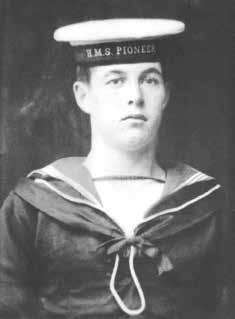
Reardon quickly moved up the ranks, and within a year of commencing his five-year naval service he was rated an Able Seaman
THE DISCOVERY OF THE WRECK SITE OF HMAS AE1 in December 2017 garnered significant media coverage within Australia and around the world. AE1 was the first submarine commissioned into the fledgling Royal Australian Navy (RAN), and would also become the RAN’s first wartime loss when it mysteriously disappeared with all hands off Papua New Guinea’s Duke of York Islands in the opening months of the First World War. Among myriad discussions ignited by AE1’s discovery were those related to its 35 crew members. All frontline RAN warships that served in the conflict were commanded by officers who were (predominantly) British in origin, while their crews comprised a mix of mostly British and Australian ratings, as well as smaller numbers of sailors from other colonies and dominions within the British Empire.
In the case of AE1, 18 men – or just over half of the submarine’s crew – were Royal Navy personnel from Great Britain. Sixteen others were members of the RAN, of whom six were from the British Isles and had formerly served in the Royal Navy. Ten of AE1’s complement were Australian-born and hailed from New South Wales, Victoria, Queensland and Tasmania. A number of these men – ranging from the submarine’s commanding officer, Lieutenant Commander Thomas Besant, to Able Seaman James Thomas – have recently had their stories highlighted in the Australian press. One crewman, however, has been largely overlooked in the media coverage of AE1 Often (anonymously) referred to as ‘the New Zealander’, John Reardon was the only crewmember not born in either Australia or Great Britain, and his story – like those of his fellow crewmen – is unique and significant.
Origins and early naval career
John Reardon was born on 9 February 1891 in Kaikoura on New Zealand’s South Island, the third son of Edward and Catherine Reardon. New Zealand was then in the midst of an economic depression and suffering from severe work shortages; consequently, Edward Reardon was unable to find employment in Kaikoura and sought work in the South Island port of Lyttelton. He later moved to Wellington, where he found work as a messenger in the Government Insurance Office. Catherine and the children remained in Kaikoura, where they were assisted by extended family. This support system proved essential when Edward Reardon suddenly collapsed and died of heart failure on Wellington’s Taranaki Street on the night of 12 November 1895. Reardon, who was ‘about 50 or 51 years of age’ at the time of his death, had recently suffered a bout of influenza, and a coronial inquest noted that ‘acute congestion of the lungs’ was likely a significant contributing factor.1
Back in Kaikoura, Catherine and the children were devastated by Edward’s death, but with the assistance of extended family avoided destitution. Catherine eventually remarried and had four more children. John Reardon, meanwhile, was educated in Kaikoura and completed his Standard 3 exams before leaving school in 1906 at the age of 15. He worked as a labourer and in the local fishing industry for a brief period before answering a newspaper advertisement in early November 1907 seeking recruits for the Pelorus class light cruiser HMS Pioneer. One of a number of warships assigned to the Royal Navy’s Australian Squadron during the first decade of the 20th century, Pioneer operated primarily as a drill (training) ship and was usually stationed in Sydney, but made occasional visits to New Zealand ports. On 21 November 1907, Pioneer arrived at Lyttelton, where it tied up at the port’s ‘Skeleton Breastwork’ berth. Reardon was also in Lyttelton by this time, and reported to the ship for assessment. After a brief interview and medical examination, he was entered on Pioneer ’s crew roster as a Boy 2nd Class – the lowest rank for incoming naval personnel aged 15 to 17.
Reardon quickly moved up the ranks, and within a year of commencing his five-year naval service (which officially began on his 18th birthday in February 1909) he was rated an Able Seaman. He remained aboard Pioneer during this time as the vessel transited between Australia and New Zealand, and made a lengthier return voyage from Sydney to Colombo, in Ceylon (modern-day Sri Lanka). Once back in Sydney in mid-1909, many of Pioneer ’s crew were transferred to other ships, but Reardon was retained to assist with instructing the next influx of trainees – a testament to his skill and the high regard with which he was held by the ship’s captain, Commander William Frederick Blunt rn
01 AE1 at Portsmouth, UK, before its record-setting voyage to Australia. Image courtesy Sea Power Centre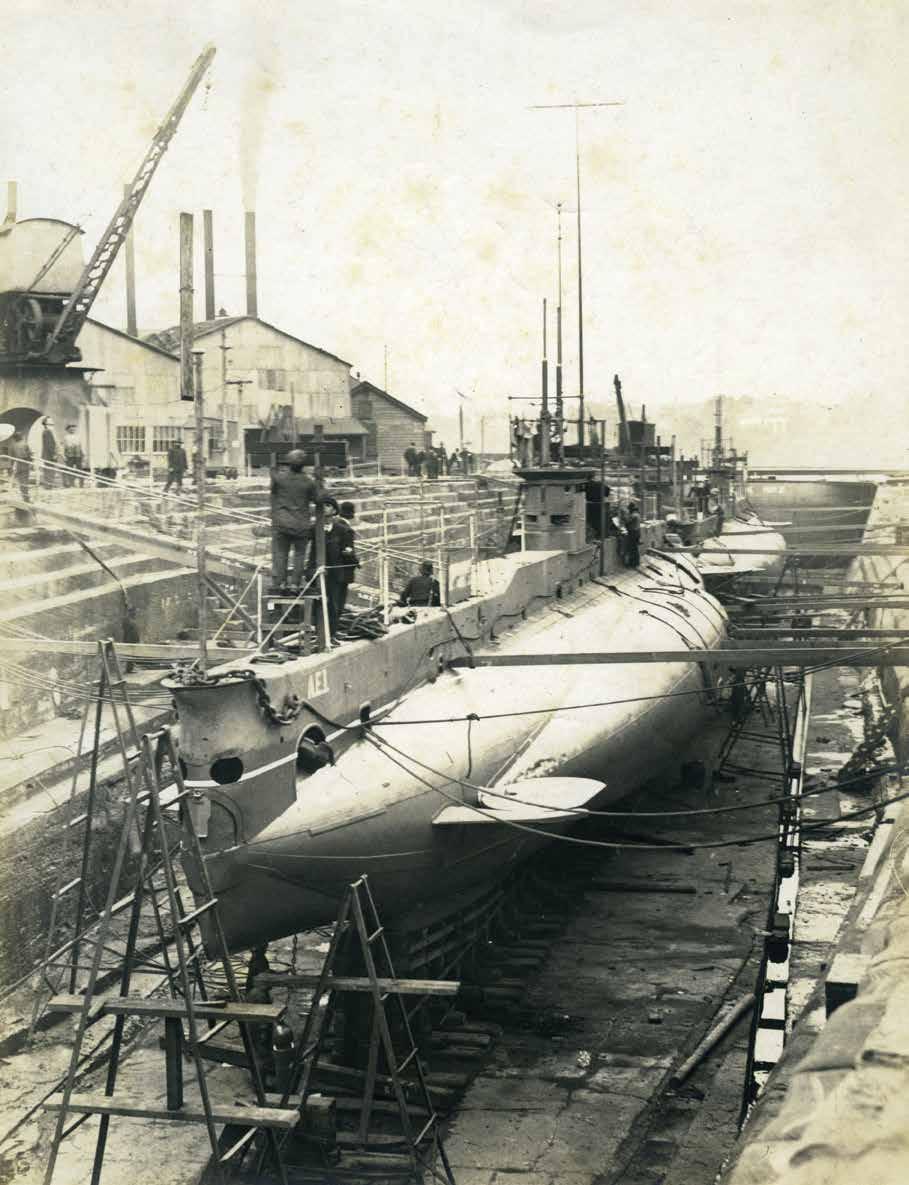 AE1 (front) and AE2 in Fitzroy Dock, Cockatoo Island, Sydney, June 1914.
AE1 (front) and AE2 in Fitzroy Dock, Cockatoo Island, Sydney, June 1914.
Those skills were put to the test in January 1910 when Reardon joined other crewmen from Pioneer in rescuing passengers and crew from the Union Steamship Company vessel SS Waikare. The steamer was returning to Dunedin from a tour of Fiordland when it struck an uncharted rock in Dusky Sound and began to sink. The captain beached the stricken ship, and Pioneer – which in a stroke of luck happened to be visiting the nearby port of Bluff – was asked to assist in a rescue operation. All of Waikare ’s 141 passengers and 85 crew were safely recovered from the wreck and embarked aboard Pioneer. Reardon was a crewman aboard one of the rescue boats and was awarded 12 pounds 10 shillings in prize money (the equivalent of about $1,700 today) for his participation.
On 6 February 1911, Reardon was posted to the Challenger class protected cruiser HMS Challenger along with 13 other Pioneer crewmen. All had volunteered to transfer to the newly established Royal Australian Navy and journeyed to England aboard Challenger during the latter half of 1912. Following his arrival at Devonport, Reardon remained in Royal Navy service until 1 January 1913, when he joined the RAN as an Able Seaman for an enlistment period of five years. His naval records describe him as 5 feet 10 inches (178 centimetres) tall with dark brown hair, hazel eyes, and a ‘fresh’ complexion. 2 Reardon’s skin tone and flushed cheeks were among his most notable physical characteristics, and earned him the nickname ‘Rosy’ among his shipmates. 3 Another physical attribute noted in his RAN service record was a tattoo on his left forearm that depicted ‘clasped hands over [an] anchor’.4
Upon enlisting in the RAN, Reardon was assigned to the London Depot to commence submarine training, which he completed on 30 March 1913. He also qualified as a Seaman Torpedoman, which meant he would have been directly involved with the operation and upkeep of torpedoes, torpedo tubes, and the compartments where the torpedoes and their warheads were stowed when not in use. Upon graduating, Reardon was nominated for service aboard AE1, which was then being completed at the shipyard of Vickers Ltd in the English port of Barrow-in-Furness. Following the submarine’s launch on 22 May 1913, Reardon joined its commissioning crew and participated in a series of sea trials and working-up voyages. He was one of two New Zealand-born sailors to be trained for the RAN’s submarine service (the other was Stoker Archibald Wilson, who was assigned to AE1’s sister submarine, AE2) and would be aboard AE1 during its record-setting 83-day delivery voyage to Australia in early 1914.
John Reardon was one of two New Zealand-born sailors to be trained for the RAN’s submarine service
Following the submarine’s arrival at Sydney on 24 May, Reardon was assigned to the submarine depot ship HMAS Penguin AE1 was transferred to Cockatoo Island Dockyard, where it underwent refit, while Reardon enrolled in additional training and qualified as a Torpedoman, 2nd Class. During this period he also had a narrow brush with death, when a naval pinnace on which he was a crewman collided with the steamship Coombar on 9 June. The pinnace was transporting equipment from Cockatoo Island to Garden Island when it altered course to avoid a collision with the ferry Kal Kal near Milson’s Point. In doing so, it inadvertently steered into the path of Coombar, which struck the pinnace amidships and caused it to sink almost immediately. Because the accident occurred at the height of winter, the waters of Sydney Harbour were very cold, and Reardon was described as ‘hampered with [his] clothes … half-frozen and almost exhausted’ when he caught a lifebuoy thrown from Kal Kal and was rescued. 5 An AE2 crewman aboard the pinnace, Leading Stoker William James Groves, was not so lucky and drowned. Reardon was later quoted by a local newspaper as believing the incident was ‘a good omen … that established for him the safety of a life at sea’ and that he was ‘convinced … he would not lose his life by drowning’.6
Sadly, this belief proved misguided: John Reardon would be lost at sea almost exactly three months later on 14 September 1914 and become New Zealand’s first-ever naval casualty and its first combat death of World War I. He was 23 years old.
References
1 ‘News of the Day’, The New Zealand Times , 15 November 1895.
2 Record of Service, John Reardon (Official Number 7474). National Archives of Australia A6770 (Service Cards for Petty Officers and Men, 1911–1970).
3 G Wright, Kaikoura Submariner: John (Rosy) Reardon. Printstop, Wellington, p 8.
4 Record of Service.
5 ‘Collision in Port: Pinnace Sunk’, Sydney Morning Herald, 10 June 1914, p 13.
6 ‘Believed in Omens: Seaman Reardon’s Conviction’, [Sydney] Sun, 20 September 1914, p 1.
Further reading
White, M, 2015, Australian Submarines: A History (2nd edition).
Australian Teachers of Media, Inc, St Kilda West.
Wright, G, 2014, Kaikoura Submariner: John (Rosy) Reardon Printstop, Wellington.
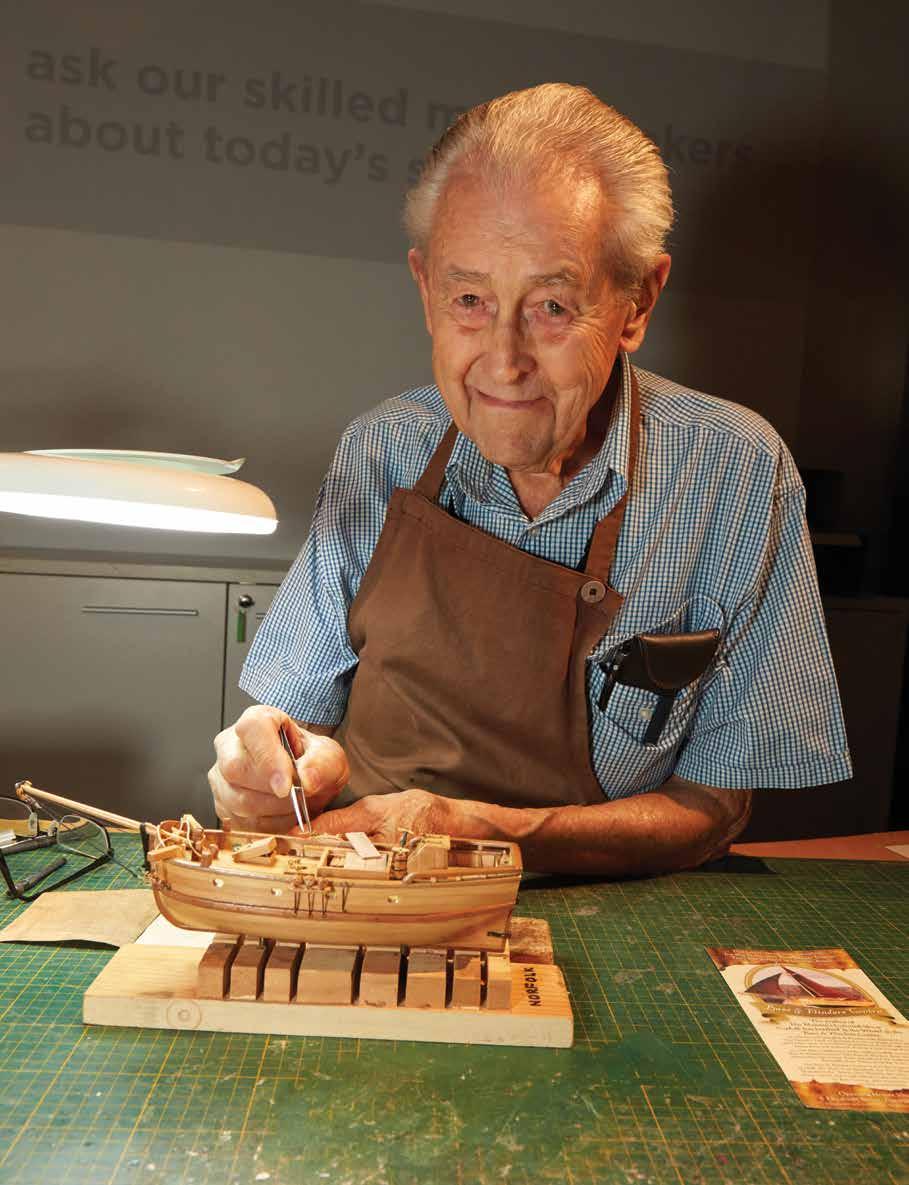
The model makers’ bench at the museum has been a much-loved fixture for many years. Behind the construction of these detailed scale models is a great deal of painstaking scholarship. With curator Dr Stephen Gapps, model makers Col Gibson and John Laing confirm some important details about one of Matthew Flinders’ vessels of exploration, the sloop Norfolk, in research they first began in 2004.
IN THE AUTUMN OF 1798, under the orders of the acting lieutenant-governor of Norfolk Island, Captain John Townson, convict workers built a small vessel from local timbers. The sloop was pushed out into the surf and sailed on its maiden voyage from Norfolk Island to Sydney – a distance of more than 1,600 kilometres – in June 1798.
But Sydney had been beset by convicts stealing vessels and trying to escape – most famously in 1791 by Mary and William Bryant, who sailed with their two small children and seven other convicts to Indonesia in an open boat. For various reasons, including a spate of ‘piratical seizures’ of vessels, colonial authorities had placed severe restrictions on boatbuilding in the colony. When Norfolk arrived in Sydney, it was immediately confiscated, having been built – unbeknown to Captain Townson – against Governor John Hunter’s explicit orders.
When Norfolk arrived in Sydney, it was immediately confiscated
Ocean-going vessels were in short supply in the colony and Hunter ordered that Norfolk be fitted out for a planned voyage under Lieutenant Matthew Flinders to confirm whether a strait existed separating Van Diemen’s Land (Tasmania) from the mainland, as Hunter himself had long suspected. He reported to the Colonial Office in England that he was ‘endeavouring to fit out a deck’d boat of about 15 tons burthen’ for this purpose. Flinders, along with George Bass and a crew of eight volunteer sailors, departed Sydney in October.
But more than a decade later, in 1814, Matthew Flinders noted that the Norfolk was a ship of 25 tons. Almost all subsequent historical references to the sloop Norfolk, presumably quoting Flinders, are to a vessel of 25 tons.
Before the model makers at the museum commenced hundreds of hours’ work on a scale model of the Norfolk, such a discrepancy in size needed to be explained. Hunter was a naval officer with considerable experience and, as governor, was unlikely to make an error of some 10 tons in his official reports back to England. But Flinders was a careful navigator and a thorough chart maker. He sailed the Norfolk on a long voyage from Sydney to Tasmania and became one of Australia’s most respected naval officers. Was the vessel lengthened at some point? Or could the meticulous Flinders have been wrong?
01 A figure on the deck provides human scale.
02
The fine and intricate detail of planking, hatches and ropes takes many hours of skilled work.
Images Jasmine Poole/ANMM

Master boatbuilder Thomas Moore was undoubtedly in charge of preparing the Norfolk at Sydney Cove for its voyage in October, making it as watertight as possible, as it had been discovered to be leaky on its journey from Norfolk Island. It would seem that with this and much other work to do on the vessel, including provisioning, it could not have been lengthened in the short time available.
There was some uncertainty in Flinders and Bass’s earlier reports on the Norfolk before 1814. Flinders had said in 1801 that the sloop Norfolk ‘was not of 25 tons burthen’, presumably meaning it was less than 25 tons. In a letter to Sir Joseph Banks in May 1799 – only four months after the event – Bass said, ‘A sloop of 20 tons burthen was fitted for the purpose. We passed through the [Bass] strait and returned by the South Cape of New Holland.’
In 1802, in An Account of the English Colony in New South Wales, David Collins wrote that Norfolk was ‘only five-and-twenty tons in burden’, which he seemed to have obtained from ‘the accurate and pleasing journal of Mr Bass’. While we know Bass had previously described the Norfolk as of 20 tons, it remains unclear how Collins arrived at 25 tons. It certainly seems he may have influenced the later account of Flinders, who possibly consulted Collins’ work in compiling his A Voyage to Terra Australis (1814).
The first description of the colonial sloop Norfolk was as ‘a decked longboat’. At this time, ‘longboat’ was a specific naval classification, along with pinnace, jolly boat, launch, cutter and barge. While these classifications were rather loose at times and varied due to conditions, the naval officers in the colony certainly knew what a longboat was.
The ships of the First Fleet all carried longboats and the early colony in New South Wales used many, both open and decked, in exploration and cargo carrying. They were the largest boats carried aboard ships, sturdily constructed and meant to carry heavy loads and lay out anchors. The First Fleet flagship, HMS Sirius, had two longboats aboard that were the standard length for that size ship at that time, which was about 25 or 26 feet in length. By contrast Cook’s Endeavour had a longboat of 19 feet.
While their size varied over time, longboats had been a standard design for the navy for many years. The size may be described by length, which may mean length of keel, length of deck, or length between perpendiculars (BP). They were also often described by the number of oars pulled. Larger boats pulled 14 or 16 oars, sometimes with two or three masts with setting sails.
While there was some standardisation, the precise length of a longboat was often determined by the best tree that could be found. To sail the open seas, a 32-foot keel boat would have been preferred to a smaller boat. This would be similar to Governor Phillip’s 16-oared boat of about 34 feet overall length. This vessel lasted very well, as Collins noted in April 1791. Could it have been the model for the first vessel built on Norfolk Island, the sloop Norfolk?
One way to work out the length of a 16-ton vessel is to compare the tonnage and length of other known ships. Museum volunteer guides Pam Forbes and Greg Jackson compiled a database of information on more than 1,000 wooden sailing ships built before 1849, and with an equation relating tonnage and length, a predictive model can be used. In this, a 16-ton vessel such as the Norfolk would be about 34 feet in length with a beam of 9 feet 10 inches.
By comparison, a ship of 25 tons would have a length of 40 feet 6 inches with a beam of about 11 feet 11 inches. This does not appear feasible as a ‘longboat’ of this period – 40 feet in length is more consistent with the early coastal schooners such as the Francis, which had been sent out in frame from England. However, a decked longboat of about 34 feet and about 16 tons eminently suits the characteristics of the colonial sloop Norfolk. 02

While their size varied over time, longboats had been a standard design for the navy for many years

There is nothing like a good historical reconstruction to test the validity of academic theorising
Finally, there is nothing like a good historical reconstruction to test the validity of academic theorising around such matters. For the 200th anniversary of Bass and Flinders’ voyage to Tasmania in 1798, Captain Bern Cuthbertson had built a reconstruction of the Norfolk to re-enact the journey, described in detail in his book In the Wake of Bass and Flinders, 200 years on
In 1996, before the re-enactment, Cuthbertson had said:
There are no known plans or identified illustrations of Norfolk ... Various historians have described her as being of 16 tons or of 25 tons ... We have settled on dimensions of 35 feet by 11 feet beam with a draught of four feet. We believe the given figure of 25 tons refers to Norfolk ’s carrying capacity when trading to the Hawkesbury River and to the Hunter.
In 2006, he remained convinced the dimensions of the Norfolk replica were correct:
Having spent two years living with Norfolk and sailing her over 6,000 nautical miles without an engine, I consider 25 tons was a mistake … I have no idea how this could have been achieved. We carried 6 tons of lead, plus water, anchors, spars, rigging and gear. This made her displacement tonnage 16.
Cuthbertson was adamant: ‘If the replica was ballasted to displace 25 tons she would have had very little freeboard and would have been a dog to handle.’
The precise length of a longboat was often determined by the best tree that could be found
So how did Flinders get it so wrong? When he was writing his Voyage to Terra Australis for publication between 1811 and 1814, he was a very sick man. He died the day after his book was published, the result of a disease he contracted in the South Pacific as a midshipman serving under Captain Bligh.
The ship Providence ’s paybook noted that Flinders underwent at least two of Surgeon Harwood’s customary ‘cures’ for venereal disease – doses of mercury. It was more likely the remedy than the actual disease that killed him.
It seems reasonable to assume that Flinders’ memory in revising his story for publication was not as faithful as he would have wished. We are reminded of other errors: he got the length of Tom Thumb [II] wrong, and the schooner Francis was 44 tons, not the 60 he referred to.
The Norfolk had a short life, sailing for just over two years from June 1798 to November 1800. Despite stringent government regulations on shipping security, it had been ‘piratically seized’ by convicts in Broken Bay, north of Sydney, in late October 1800. But as with many attempted escapes from the colony, the convict pirates didn’t get far. The wreck of the Norfolk was found on the north side of the Hunter River, at Newcastle near the present-day town of Stockton, at a site still called Pirate Point.
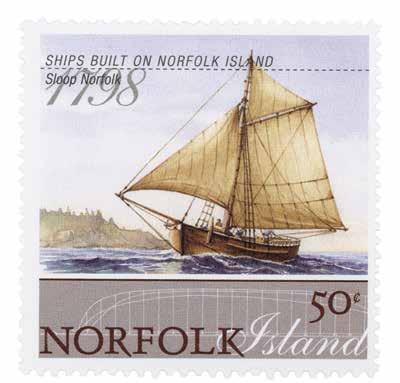
The authors contend that all references above to the sloop Norfolk while it was still sailing are more accurate than reports made more than a decade later. We conclude that the original report to the British Navy should stand – that is, ‘Colonial sloop Norfolk, 16 tons’.
Even though Flinders published it once, and many authors since have quoted (and still quote) 25 tons, it should in fact be 16 tons. Indeed, it is practicably unfeasible for a decked longboat of those dimensions to have been 25 tons at that time.
The authors conclude that, perhaps surprisingly, the man who sailed the vessel around Tasmania in 1798 – Flinders – was wrong, and Governor Hunter was correct.
Notes
For extensive notes and further reading, readers are referred to the full version of this article, published in Academia, 12 September 2017: academia.edu/34554380/Flinders_and_his_Sloop_Norfolk_evidence _re-assessed
Col Gibson and John Laing wish to thank Australian National Maritime Museum curator Dr Stephen Gapps for his assessment of their conclusions. Please see Signals No 110 (March–May 2015) for an article about co-author John Laing, master mariner and model maker.
Autonomous vehicles – commonly known as drones – are revolutionising maritime industries and research. Aerial drones can improve surveillance, safety and efficiency; underwater drones can gather data for mapping and surveying work, and even search for missing aircraft. Dean Cook looks at the latest developments in maritime robotics.
A STEALTHY ELECTRIC SHIP navigates silently along the headland until its sonar detects an anomaly on the seabed.
A small team of propeller-driven robots is deployed automatically from port and starboard. The underwater robots receive their mission from the ship, divide up the tasks and dive to the bottom to interrogate the anomaly with an array of optical and acoustic sensors, then spread out looking for more. They may be looking for wreckage, an enemy submarine, a poorly mapped pipeline or an oil-well blowout, but the information that they collect is transferred back to the ship and relayed to a control centre on the other side of the earth. A flashing light on the console alerts the first human in the loop that the autonomous roving fleet has found something.
While we might not be there just yet, this vision of fully remote operations isn’t fantastical. Overwater and underwater, a rising tide of maritime robots is playing an ever-greater role in Australia’s maritime capability – and AMC Search, the training and consulting specialist division of the Australian Maritime College, is at the forefront of these scientific developments.
But the world of robotics poses a heady dose of confusion to the casual observer, starting with its various abbreviations (UAV, AUV), raft of overlapping names (drones, Autonomous Marine Vehicles, Unmanned Aerial Vehicles, Unmanned Aircraft System) and distinctions that aren’t always well defined.
Despite the perplexing nomenclature, robots used above and below water fall into two distinct groups, albeit with very similar names.
The aerial drone is officially called an Unmanned Aerial Vehicle, or UAV. This can refer to any aircraft without a human pilot on board, but most recently has become synonymous with the small helicopter-like vehicles flown by millions of people around the globe. These consumer and commercial UAVs are operated by a ground-based controller. They can travel tens of kilometres away from their ground stations, beaming back real-time images and video.
In the maritime sector, UAVs are deployed for surveillance, safety and efficiency, explains Dr Joel Spencer, CEO of The Institute for Drone Technology:
The potential for drone technology in maritime is enormous and focuses on improving safety for workers. Drones can safely go where humans can’t. For example, a drone can carry out a tank inspection in an enclosed space that contains a noxious gas, or it can help a vessel avoid hazards such as icebergs and pirates by surveying the water ahead of a ship’s course.
There are further applications: aerial drones are already being used by ports to monitor traffic, and trials have been carried out using drones to deliver supplies to ships at sea.
Significantly less visible – but no less powerful – is the aerial drone’s underwater cousin, the Autonomous Underwater Vehicle (AUV). In common with the UAV, AUVs are programmed and driven from on-shore computers. Both AUVs and UAVs can range in size from hand-held to just squeezing into a 40-foot shipping container.
The world of robotics poses a heady dose of confusion to the casual observer
AMC Search’s Nupiri muka, an Explorer-model AUV, on a test dive. Nupiri muka means ‘eye of the sea’ in palawa kani, the language of Tasmanian Aboriginal people. Image Damien Guihen

AUVs can dive hundreds of metres below the ocean’s surface and use tools such as sonar to gather information from the depths of the ocean. They can’t rely on radios or GPS for communication and so must use lower-bandwidth acoustics for data transmission. These subsea robots are being deployed for a host of survey and mapping work, such as climate research, patrolling fishing grounds, mapping the ocean floor, carrying out pipeline surveys and searching for missing aircraft involved in air crashes.
In many ways, the real power of AUVs lies in their ability to act as a force multiplier: a ship able to deploy eight small AUVs can now be in nine places at once. This can improve how efficient and effective a vessel can be when it’s surveying the ocean (a fleet of AUVs was used by Ocean Infinity, the company that searched for the missing Malaysian Airlines flight MH370).
For mariners, both AUVs and UAVs have enormous transformative potential that is slowly being realised outside a test environment. Technological advances under way will see the vehicles travel further, with batteries that last longer. This will mean they can do more and be more useful, travel further out to sea and carry out more complex activities with less human intervention.
But as with self-driving cars, autonomous vehicles in the air and the ocean provoke a host of complex questions: Are they safe? Are they reliable? Who is liable in the event of an incident? What degree of human oversight is required?
These questions are not easy to answer. While many of the thorny issues are being tackled by bodies like the Australian Maritime Safety Authority, organisations have started upskilling staff or bringing in new expertise to help take advantage of the technology.
In this sense, robots are already affecting seafaring and maritime careers. New opportunities are presenting themselves. Humans will be needed to oversee and manage autonomous systems, and those organisations that understand early on how the technology can work for them will reap rewards. Maritime employers will be demanding new robotic skills in the near future, according to Training Manager at AMC Search, Emilie Donovan:
As the applications of drones in the maritime industry become better understood, and drone usage increases in our sector, the need for specialised maritime autonomous systems training is apparent. Training should not only provide people with the skills needed to carry out drone work, but also to become leaders in the integration of drone technology into maritime in their own right, including establishing policies and procedures that govern their use.
AMC Search, a partner of the Australian National Maritime Museum, runs aerial drone courses tailored to the maritime industry, in collaboration with the Institute for Drone Technology. It also provides exclusive commercial access to the Australian Maritime College’s Autonomous Underwater Vehicle facility for survey and consultancy work. Visit amcsearch.com.au for more information.
Dean Cook is CEO of AMC Search
The Australian National Maritime Museum has recently acquired a small fleet of Remotely Operated Vehicles (ROVs) and has been exploring beneath the surface of Sydney Harbour with students as part of our maritime archaeology program. From March we will be giving everyone the chance to get handson with some of the latest underwater technology and test their skill as an underwater drone pilot. See page 56 and visit sea.museum for details.
Once upon a time, two Australian surfers got sick of swimming in garbage, so they decided to do something about it. The result is an ocean rubbish bin that has now been installed around the world, writes curator Emily Jateff.
IN 2015, Australian boatbuilder Pete Ceglinski and sailor Andrew Turton quit their jobs and sourced seed funding to design a prototype ocean rubbish bin, or ‘Seabin’, that functions like a large pool skimmer. It worked brilliantly. The Seabin V is now fully operational and installed at marinas around Europe, the UK, the USA and, from this month, on active permanent display at the Australian National Maritime Museum.
Plastic pollution is one of the top three dangers to ocean health (the others are acidification and warming). Eight million tonnes of waste — most of it plastic — is added to the oceans each year.1 Mats of macro (big) and micro (small) plastics aggregate in naturally occurring ocean currents, or gyres, forming floating plastic structures on the surface of the oceans. An example is the Great Pacific Garbage Patch, halfway between Hawaii and California. Plastics can be ingested and kill marine life. Nano plastics – very small particles – have even been found in plankton. Plastics are in our clothes, our food, our water. Plastics are everywhere.
The Seabin works like this: a 110- or 220-volt motor pumps water through the unit, sucking debris on the surface of the water within a six-metre radius of the bin and into a catch-bag/filter, then pumping the now-clean water back out. The bin is equipped with oil-absorbent pads that clean surface water of petroleumbased oils and detergents, and with the addition of a fine-weave mesh on the filter, micro-fibres can be captured. Both bin and catch-bag are fully recyclable and the bin can be run on solar power as a carbon-neutral alternative. The catch-bag can be removed, cleaned and replaced, allowing for continuous operation.
The life span of a Seabin is estimated at three to five years, but in reality Seabins are built to last, with only the low-voltage water pump being replaced every two years and the catch-bags every 12 to 18 months.
01 Rubbish collected by a Seabin at the museum over a two-week period in late 2018. Image seabinproject.com
02
A Seabin installed at the museum. Image Andrew Frolows/ANMM
To maximise collection, Seabins are mounted to floating docks or wharves at strategic places in heavily trafficked waterways. This is a front-line approach: capturing debris deposited into the water at its most common source (near land) means less of it will work its way out into the oceans. While larger items won’t fit in the catch-bag, the unit creates enough flow to pull larger debris up against the bin, allowing for easier hand-collection (like a two-metre piece of foam we hand-collected from next to the bin last year).
The Australian National Maritime Museum was proud to host the Australian trial of the Seabin on 8 June for World Oceans Day 2018. This event was such a success that the Seabin returned for a two-week installation in August, during National Science Week. Visitors watched as staff and volunteers across the museum helped to check the bin and empty the catch-bag – a great reminder that we are all in this together.
The Seabin Project isn’t just about a floating rubbish bin. As proponents of a ‘whole-solution strategy’, staff engage with schools and communities to discuss how limiting our purchase and use of plastics reduces our plastic footprint and diminishes overall ocean waste. The project dedicates 50 per cent of its time and effort to technological innovation and 50 per cent to education. As CEO Pete Ceglinski says, ‘education is prevention and that’s the real goal’. The museum agrees, and has committed to offering sustainability programming at our site from 2019.
The Seabin is a practical, on-the-ground approach to reducing visible waste in public waterways. The Australian National Maritime Museum is pleased to announce that global recycling company TOMRA has sponsored the first permanent Seabin in Darling Harbour. Take a stroll along the museum’s waterfront and visit our Seabin, now on display – and hard at work collecting rubbish.
1 Jambeck, JR, Geyer R, Wilcox C, Seigler TR, Perryman M et al (2015), ‘Plastic waste inputs from land into the ocean’. Science 347, 768–771.
TOMRA is helping to create a cleaner, healthier and more sustainable planet through innovative recycling solutions. Recycling your drink containers through a TOMRA Reverse Vending Machine is one of the best ways to ensure they are recycled into other drink containers. Visit mytomra.com.au for more information.

Seabin statistics
What a Seabin can catch each year:
• More than 117,000 plastic utensils such as cutlery
• 90,000 plastic shopping bags
• 50,000 plastic water bottles
• 35,600 disposable cups
• 11,900 large plastic bottles
Five-litre containers also fit inside a Seabin.
Twenty-litre containers will not fit inside the Seabin, but are kept against the side of the bin due to the flow of water, allowing for hand-collection.
Seabins can skim surface oil and pollutants from the water and catch micro-plastics two millimetres in size.
Cigarette butts are the most commonly caught items in Seabins; plastic particles are the second.
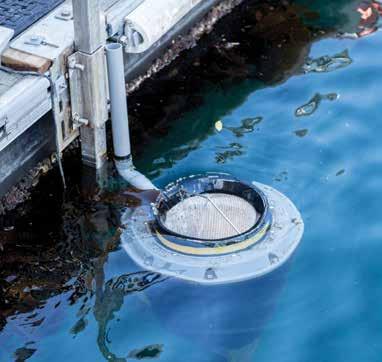

After falling in love with a century old-wooden yacht, a Sydney family researched its historic significance by charting its early days in Auckland, its builder, the environment in which it was created and some of its owners in New Zealand and Australia. Then, when the time came, they ensured that the boat was returned to its country of origin. Catherine Shirley traces the story of Ida.
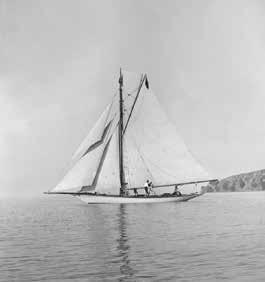
01
Ida on the foreshore at Devonport, New Zealand, 1904. Sir George Grey Special Collections, Auckland Libraries, 37-230
02
Ida, 1900–1909. Sir George Grey Special Collections, Auckland Libraries, 37-97
The Bailey and Logan boatbuilding families, widely regarded as being the founders of the yacht building industry in New Zealand, were fierce competitors
‘SHE’S WORTH EVERYTHING AND NOTHING,’ said boatyard owner Sean Langman, squinting in the afternoon light. He stood looking down sternly from the dock at our boat, Ida, moored alongside his boatyard. We’d been called down there to answer a few questions about her hull before they agreed to haul her out for much-needed anti-fouling. Roads & Maritime Services weren’t happy with her visible state, and neither was Sean Langman. ‘She could break up if we haul her out – just look at that deck. And if that happens, we only have a chainsaw solution.’ He shook his head. I almost cried.
My husband replied, ‘She’s got a triple-planked kauri hull. She’s strong. Ignore the state of the deck, that’s not where her strength lies. She’s been careened on New Zealand beaches.’ Sean climbed down to look at her interior more closely and returned, muttering, ‘I promised never to fall in love with another wooden boat.’
The following day, Ida emerged from the waters of Sydney Harbour, her hull covered in barnacles. As she was cleaned off, shipwrights sidled over to give her a closer look. ‘Beautiful hull,’ they said time and time again, but then gave that pitying look. They’d heard. Ida needed saving. It was 2017, and after 19 years in our family, it was time she moved on to her next custodian.
The early days
Ida was launched in December 1895 in Auckland, New Zealand. Built by the Bailey Brothers for the Jagger brothers and W Frater Jnr, and named after the late Samuel Jagger’s daughter, Ida, she was designed to win against the Logan-designed boats on Waitemata Harbour and offshore from Auckland, where the big yachts could duel. These 5-Raters1 were gaff-rigged with acres of canvas, two winches and eight to twelve men on each boat.
Captained by hard task-masters, this was the sport of the newly wealthy merchant class of Auckland and the battle zone of two Auckland boatbuilders.
The Bailey and Logan boatbuilding families, widely regarded as being the founders of the yacht-building industry in New Zealand, were fierce competitors following Robert Logan’s arrival from Scotland in 1874. Logan brought with him skills and expertise gained on the Clyde, which was then the worldleading centre of yacht design. He also brought his family and established a boatbuilding business. Three of his sons, Archibald, John and Robert Jnr, later set up on their own as ‘Logan Bros’.
Robert Logan had made a name for himself with Jessie Logan and several other crack yachts when in 1888 he designed and built Akarana (now part of the Australian National Maritime Museum’s on-water fleet). His sons’ firm, Logan Bros, later built the big A-class yachts Thelma, Ariki, Rainbow, Iorangi and Rawhiti, plus a number of 30-foot Linear Raters that sailed on Sydney Harbour, including Cullwulla, Petrel and Sunbeam
Charles Bailey Jnr, born and raised in Auckland, came from a boatbuilding family established by his father, Charles Bailey Snr, in 1870. The Baileys produced many commercial and recreational vessels for New Zealand and the South Pacific and had a reputation for designing any type of racing craft that was ordered from them.
Most of Charles Bailey Jnr’s early yachts were built at night by candlelight, after the real work of his father’s company had finished for the day. In 1893 he built several racing yachts, including the 24-foot mullet boat Mizpah and the 2.5-Rater Rogue. From 1894, with his brother Walter, trading as ‘C & W Bailey’, he built Rangatira, Atalanta, Ida, Zinita, Constance, Miharo and Cooee. The cruising cutter/yawl Heartsease, designed by Trevithick, also came out of their yard.
02
Yacht-building materials
This was a time of timber, with old-growth forests being logged all around the world for industries, infrastructure, houses and ships: English oak in Great Britain; Australian cedar, Huon pine and celery top pine in Australia; longleaf yellow pine in the USA; and kauri in New Zealand.
Kauri ( Agathis australis) grows naturally only in the upper North Island of New Zealand. Most old-growth trees were removed between 1840 and 1920, with those that remain located in the Coromandel, Great Barrier and western Northland. The largest kauri tree recorded had a girth of 20 metres.
The Logans and Baileys bought kauri by the ton. Long, straight and knot-free, its trunks and branches made excellent, strong planks that reached the full length of the vessels. Renowned as a highly durable wood, kauri was happy to stay moist – though only in saltwater, not fresh.
19th-century yachting technology and racing
In the late 19th century, international yacht design improved rapidly to meet the leisure needs of an increasingly wealthy middle class in the USA, Great Britain, Australia and New Zealand. In 1891, the ‘Wizard of Bristol’, Nat Herreshoff, created a new keel profile at his boatyard on Rhode Island for the US yacht Gloriana that eliminated the clipper bow and deep forefoot, considered essential elements of yacht design until that time. This was quickly followed in 1892 by Scotsman G L Watson’s design for Britannia, built for the Prince of Wales, and her sister-ship Valkyrie II. Both of these vessels were similar in hull design to Gloriana but featured a rounded or ‘spoon’ bow. Fife and other designers followed suit, with International Rating rules also driving change.
The principal rule change at the end of the 1880s was one that created a ‘rating’ for sailing yachts. Under the changes, old ‘tonnage’ rules that only took account of length on deck, beam and depth were changed to take into account sail area and waterline length and were not overly concerned about beam. These rule changes created two new sailing yacht classes, the 2½-Raters and 5-Raters. They were further refined in 1895 to an international measurement formula called the ‘Linear Rating Rule,’ which measured various hull and rig aspects and calculated a rating that corresponded approximately to the waterline length of a vessel in feet.
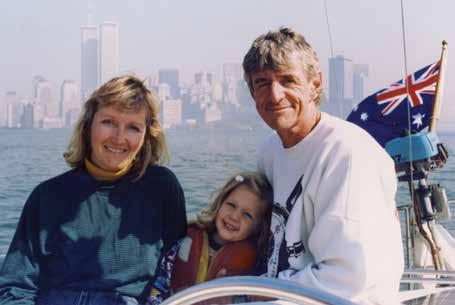
Ida vs Moana
On Ida ’s launch in December 1895, the New Zealand Herald reported:
On Saturday morning a new five-rater yacht was launched … The Ida trimmed beautifully when she took the water and is a very handsome craft, and judging from her lines should be very fast, and add more laurels to those already gained by her builders. She went out for a trial spin on Saturday afternoon, and took part in the yacht club manoeuvres, and was greatly admired, and her owner should feel very proud at having such a fine little vessel.
The beginning of the 1895–96 yacht racing season in Auckland produced two new yachts: Moana, built by Logan Bros for the Wilsons of the New Zealand Herald and launched in November, and our Ida, launched the following month. They were both 5-Raters, and highly competitive.
Moana had the new spoon bow and, from accounts in the press, looked ‘very powerful’. Her dimensions were 46 feet (length on deck), 32 feet 9 inches (length at waterline), 9 feet 6 inches (beam) and 7 feet 4 inches (draft). She was built of a two-skin diagonal construction and had a pole mast. Ida ’s dimensions were 46 feet 6 inches (length on deck), 30 feet (length at waterline), 9 feet 1 inch (beam) and 7 feet (draft). She also had a pole mast but was of three-skin diagonal kauri construction. From the outset, although of similar design, Ida found it difficult to catch Moana for several years.
That was until 1899, when Ida was sold to Charles Primrose Murdoch, Commodore of Auckland Yacht Club, which became Royal New Zealand Yacht Squadron in 1902. Primrose had admired Ida for a while, but thought she needed a little finetuning to become a winner. He had her rig and sails updated and a new brass rudder cap affixed that showed her name, the yacht club’s flag and the initials RNYS.
By the beginning of the 1900–01 season the Herald reported that she had ‘greatly improved in sailing powers’, and in December 1900, in a howling northeaster, Murdoch, skippering Ida, claimed victory in the Open Race at the Ponsonby Regatta.
01 Catherine Shirley, her husband Jerry Brookman and their daughter Victoria on a previous boat, Razoo, in New York, 1989. Ida on Sydney Harbour, late 1990s.
Ida’s middle age – changing hands
There are two types of old boats – classic and just plain old. Ida was never the latter. When she lost her charm for Charles Primrose Murdoch in 1908, he sold her on to the Nathans. She was then sold on to the Smails, the Jenkinsons, Arthur Angell, and Mirams & Pinkerton, with her final New Zealand owners thought to be Pratt and De Bruin (1962). In her middle age, she was a family boat.
How Ida came to Australia and who she was sold to after 1962 remain a mystery. Rumour has it that she arrived as ship cargo into Port Melbourne and was then sailed up the coast to Sydney. Certainly, the silence that surrounds this mystery may have something to do with New Zealand’s Antiquities Act 1975, now the Protected Objects Act. What is known is that sometime in the mid-1980s, she was purchased in Australia by Piers Dudley-Bateman, an artist of international repute. Piers and a friend hauled her out onto the hard at an old wharf in Sydney Harbour, propped her, sanded her back, refastened and re-splined her planks and painted her up.
Ida’s journey with my family
I first saw Ida in 1998. My husband, children and I cruised around her in a powerboat, and Jerry fell in love with her. He had to have her. We offered a reasonable price, and she was ours.
Our children, then aged 4 and 11, took to her as a curiosity as we cruised around the old industrial bays of Sydney Harbour.
We weren’t novices to sailing or yachts. My family had sailed for generations on Sydney Harbour and Pittwater. In addition, my husband and daughter and I had sailed the east coast of the USA in a 35-foot Scanmar for a year in 1989, immersing ourselves in the maritime heritage of the region.
For the first 10 years that we owned her, Jerry worked hard to restore her, drawing on the skills he’d learnt while restoring an 1850s house that we’d owned previously. He varnished her cabin, re-rigged her and hauled her out for anti-fouling on numerous occasions in a small boatyard that could take a draft as deep as Ida ’s.
We built up a mates’ network on the harbour: people who would tell us where to buy fittings and fixtures, who would race with us, and who would look out for Ida if her pump failed in a bad storm.
Ida would be saved for future generations through an act of pragmatism and the New Zealand government’s generosity
01 Items sent with Ida to New Zealand. Image Catherine Shirley and Jerry Brookman 02
Ida being trucked from Sydney to Port Kembla, 2018, before being shipped to Auckland. Image Seven Star Yacht Transport
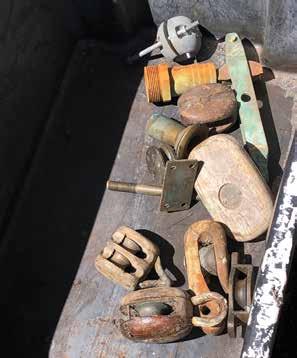
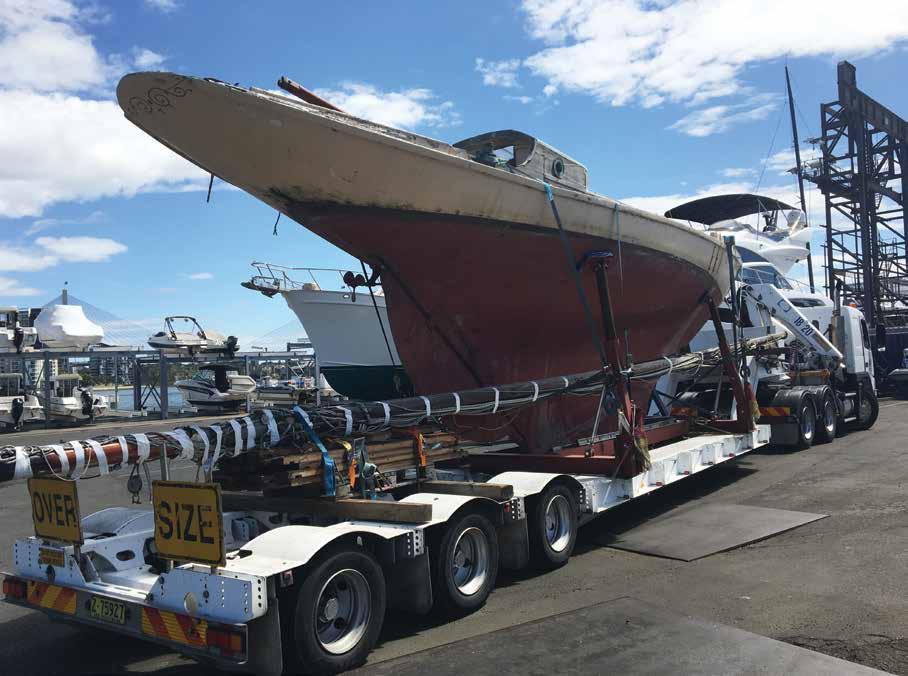
We sailed Ida up and down the coast to Broken Bay and Port Hacking, exhibited her at the Maritime Museum’s Classic & Wooden Boat Festival and occasionally raced her in classic yacht races out of the Sydney Amateur Sailing Club and the Balmain Regatta, where in 2002 she won her race. We had fun. It would be good to say that old people also only come in two types, classic and old – but there is really only one type. Old is hard. Losing faculties and strength is hard. Incapacity to clamber over rocks to a dinghy is hard, so hard that you don’t do it as much as you should. Fittings and rigs rust, sail covers tear in high winds, and decks, if not protected, rot with freshwater intrusion from rainstorms. It was time to think of saving Ida and passing her on to people who could care for her.
Return to Auckland
I first started to think about Ida ’s return to New Zealand in about 2015. It was a bit of a pipedream. I didn’t have the money to ship her back there myself to sell her, but I knew that was where she should go. She was part of New Zealand’s heritage, not Australia’s.
Through networking and web searching, I found Harold Kidd, an eminent New Zealand maritime historian, who gave me several leads. I received a few nibbles, but no results until 2018, when I received a call from John Street of the Classic Yacht Charitable Trust (CYCT) of New Zealand.
The CYCT was formed in 2002 when the historic classic yacht Waitangi, then based in Melbourne, was put up for international tender. It was feared at that time that unless action was taken to purchase Waitangi, she could be lost to both New Zealand and the southern hemisphere. Swift action was taken, and Waitangi was secured by the CYCT. Since that time, Bandit, Daring , Francis, Gloriana, Kotiri, Kupe, Rainbow II, Te Hauraki and Thelma have also been added to the fleet.
In 2018 John Street was looking for a new project, another classic yacht to restore – this time, a Bailey. John’s search had brought him to Sydney previously to see Heartsease, but she’d already been beautifully restored and wasn’t the project he was looking for. By chance, he heard of Ida, and that she was up for sale. Heartsease would stay in Sydney, but Ida could be saved.
I can’t say that there was any love attached to the sale of Ida, just sadness at saying goodbye. We made sure that she was sent off with heritage items that could assist in her restoration – 20 kauri deck beams and a variety of classic yacht fittings and fixtures, all packed securely down below.
After 19 years in our family, it was time Ida moved on to her next custodian
On 27 November 2018, Ida was taken off her mooring by Sean Langman’s team, towed to Balmain, hauled out, de-rigged and put on a truck for transport to Port Kembla. She was cargo bound for Auckland. Selling her and arranging her shipping had taken much longer than we had anticipated, but she would be saved for future generations through an act of pragmatism and the New Zealand government’s generosity.
A lot has been written about the time, commitment and money that it takes to both restore and maintain a classic yacht. Australia doesn’t have the same charitable trusts as New Zealand has to restore heritage items, so private owners of wooden boats that fall into disrepair have few options, often scrapping, abandoning or breaking them up. In some cases, they simply sink at their moorings.
We feel privileged to have been Ida ’s custodians for 20 years, to have learnt her history and embarked her on her journey forward. We look forward to meeting her again in Auckland in a few years’ time – perhaps to watch her duel again on Waitemata Harbour with her former rival, the 5-Rater Moana, now waiting quietly at her Devonport mooring, 100 years later.
Footnote
1 The two yacht rating rules to which the Logans and Baileys worked produced racing classes that were called by their rating number. Moana and Ida were built to race under the Waterline Length and Sail Area rule and were 5-Raters – meaning the equation used by the rule to take into account the yacht’s waterline length and sail area gave an answer of five. When this Waterline Length and Sail Area rule was replaced by the Linear Rule, more dimensions were recorded and put into an equation, which gave a result that was often similar to their waterline length. The new classes were called Linear Raters, and a number of them with a rating at or very near to 30 were built to race on Sydney Harbour as their own class. Five of these were designed and built by Logan Bros.
References
‘Ida’ (2018), retrieved 1/1/2019 from classicyachtcharitabletrust.org.nz/trust_ boats.htm?boat_id=16
Elliot, R, Kidd, H, and Rodney Wilson, T L, Winkelmann’s Waitemata – Classic Auckland Yachting (1998), David Ling Publishing in association with Auckland Museum, New Zealand
Kidd, H, Elliott, R, and Pardon, D, Southern Breeze – a History of Yachting in New Zealand (1999), Viking, Auckland, New Zealand
Lean, T, Traditional Wooden Boatbuilding and Restoration in the New Millennium (2007), International Specialised Skills Institute, Melbourne, Australia
Catherine Shirley is Executive Officer of the History Council of New South Wales. She has a graduate degree in History and postgraduate qualifications in Adult Education, eLearning and Human Resource Management. In her earlier career, she was an ABC-TV producer/director of science, social, arts and history documentaries.

The museum has recently published its Reconciliation Action Plan. This two-year plan sets out our commitment to recognise, appreciate and celebrate our country’s rich and unique Aboriginal and Torres Strait Islander cultures and cultural heritages, and to provide opportunities for Aboriginal and Torres Strait Islander peoples and businesses, across every facet of the organisation. By Beau James .
AT THE AUSTRALIAN NATIONAL MARITIME MUSEUM, we have deep respect for the many millennia of continuous culture and knowledge of Australia’s Aboriginal and Torres Strait Islander peoples. We believe that histories, including the consequences of dispossession of first peoples, are fundamental to understanding contemporary Australia.
Since opening in 1991, the museum has strived to engender appreciation of Aboriginal and Torres Strait Islander cultural heritage, based on respect and a commitment to consultation with community at every stage. A key tenet of the museum is the belief that to understand Australia fully, you have to understand its peoples’ many and varied links to their waterways and the sea – and none have links that are longer or deeper than those of Australia’s First Peoples.
Our latest step in this continuing process is the development of a Reconciliation Action Plan (RAP).
In November 2018 the museum’s governing Council approved the museum’s first Reconciliation Action Plan. Reconciliation Australia gave final approval of the RAP on 22 January 2019.
The museum’s reconciliation journey has been under way for more than 13 years and substantial progress has been made. The support and promotion of Aboriginal and Torres Strait Islander maritime heritages has been a priority in the museum’s Corporate Plan since 2015. The outcomes and strategies in the Corporate Plan are strongly aligned with advancing the various dimensions of reconciliation and the museum has made remarkable progress in this area.
The museum’s vision for reconciliation, as set out in the RAP, is:
A nation that understands, values and has deep respect for Aboriginal and Torres Strait Islander peoples and, especially, their maritime heritage and culture. We aspire to be an employer of choice and preferred business partner of Aboriginal and Torres Strait Islander peoples.
Some key actions in the draft RAP include:
• the establishment of an Indigenous Advisory Group;
• a commitment to use Encounters 2020 to advance reconciliation; and
• an aspiration to enhance the quality of information about community and language in our collection records during the 2019 Year of Indigenous Languages.
Visiting artists from Arnhem Land share their culture through traditional dance at the opening of Gapu Monuk – Journey to Sea Country, which showcased the landmark Saltwater collection of bark paintings by the Yolŋu people. The exhibition was critically acclaimed in the media and also won the 2018 International Design and Communications Award for best scenography and the 2018 national MAGNA award. Image Andrew Frolows/ANMM
We are also moving to the community’s preferred language of ‘Aboriginal and Torres Strait Islander peoples’ rather than ‘Indigenous’.
The museum supports and promotes Aboriginal and Torres Strait Islander cultures and maritime heritages by:
• creating and enhancing pathways for participation by Aboriginal and Torres Strait Islander communities and groups in our programs;
• recognising and reflecting Aboriginal and Torres Strait Islander cultures, heritage and languages throughout our programs, exhibitions and publications, including for National Reconciliation Week and NAIDOC Week;
• becoming a signatory to the Indigenous Art Code;
• ensuring that all museum staff and volunteers are culturally aware;
• creating employment, training and volunteer opportunities for Aboriginal and Torres Strait Islander people at the museum;
• building partnerships with governments, community and industry across Australia to support Aboriginal and Torres Strait Islander cultural, educational and training programs; and
• membership of Supply Nation and using best endeavours to comply with the Commonwealth’s Indigenous Procurement Policy.
As a member of the Reconciliation Action Plan community, the museum joins more than 1,000 corporate, government and not-for-profit organisations that have formally committed to reconciliation through the RAP program since its inception in 2006. RAP organisations across Australia are turning good intentions into positive actions, helping to build higher trust, to lower prejudice, and increase pride in Aboriginal and Torres Strait Islander cultures.
I strongly believe that continued protection and promotion of traditional and contemporary Aboriginal and Torres Strait Islander cultural expressions are crucial for our First Peoples, and for achieving reconciliation. The museum’s RAP is fundamental to realising this vision
– Australian National Maritime Museum Director and CEO, Kevin Sumption PSM
Reconciliation Australia’s five dimensions of reconciliation
Reconciliation is no one single issue or agenda. Based on international research and benchmarking, Reconciliation Australia defines and measures reconciliation through five critical dimensions:
1. Race Relations
All Australians understand and value Aboriginal and Torres Strait Islander and non-Indigenous cultures, rights and experiences, which results in stronger relationships based on trust and respect and that are free of racism.
2. Equality and equity
Aboriginal and Torres Strait Islander peoples participate equally in a range of life opportunities and the unique rights of Aboriginal and Torres Strait Islander peoples are recognised and upheld.
3. Institutional integrity
The active support of reconciliation by the nation’s political, business and community structures.
4. Historical acceptance
All Australians understand and accept the wrongs of the past and the impact of these wrongs. Australia makes amends for the wrongs of the past and ensures these wrongs are not repeated.
5. Unity
An Australian society that values and recognises Aboriginal and Torres Strait Islander cultures and heritage as a proud part of shared national identity.
Co-curating travelling exhibitions, running workshops across the country, advocating on behalf of the maritime heritage community, discussing topics of interest, sharing common challenges: these are just a few of the things that Australia’s maritime museums do when they get together. Sharon Babbage profiles the work of the Australian Maritime Museums Council.
The Port of Echuca Discovery Centre is represented on the AMMC Board and was the venue for the AMMC’s most recent workshop and Annual General Meeting. Image courtesy Port of Echuca Discovery Centre
ORIGINALLY ESTABLISHED as a special interest group of Museums Australia (the professional body for the museum industry), the Australian Maritime Museums Council (AMMC) is now a membership-based, not-for-profit company managed by a board.
Despite their similar names, the Australian Maritime Museums Council should not be mistaken for the governing Council of the Australian National Maritime Museum. Although the National Maritime Museum supports the AMMC’s aims and operations, the AMMC is a completely separate organisation. It’s been around almost as long as the National Maritime Museum –more than 25 years – and exists as a result of collaboration by maritime museums around the country.
There are eight institutional members of the Board (these organisations must be represented according to the AMMC’s constitution): Sydney Heritage Fleet, Australian National Maritime Museum, South Australian Maritime Museum, Queensland Maritime Museum, Council of Inland Rivers, Maritime Museum of Tasmania, Port of Echuca Discovery Centre and Western Australian Maritime Museum.
There are also eight elected delegate Board members, who currently come from the Australian National Maritime Museum, Bass Strait Maritime Centre, Jervis Bay Maritime Museum, Museum and Art Gallery of the Northern Territory, Western Australian Maritime Museum, Maritime Museum of Townsville and Albany’s Historic Whaling Station, with a vacancy for Victoria.
The AMMC exists to be a network of Australia’s maritime heritage interests. It provides a forum to discuss ideas, exchange information about best practice for the management of museums and the heritage vessels in their collections, build contacts and advocate to preserve Australia’s maritime heritage.
The collective aim of members is to make maritime heritage more accessible to Australians. Like the National Maritime Museum, the members of the AMMC recognise that, all too often, people see their history mainly in terms of great events and national icons. Yet there are real stories of interest and significance in regional museums, historical societies, interest groups, clubs and communities.

The AMMC is a meeting point for its members to, as our tag line says, ‘Connect, Discuss, Share Maritime Heritage’. The realities of restoring and maintaining operational historic vessels, whether it matters to save an old ship, how to stage low-cost exhibitions: these are some of the things that keep our members awake at night, so these are the topics that we discuss when we get together.
The AMMC also advocates and collaborates with the Australian Maritime Safety Authority (AMSA) regarding the unique regulations for Marine Safety (Heritage Vessels) regulations.
The AMMC’s website and Facebook page aim to foster an online community across Australia’s vast distances. They provide information about grant funding sources such as the Maritime Museums of Australia Project Support Scheme (MMAPSS); the Australian Register of Historic Vessels (ARHV); advice on national standards and best practice regarding collections law, as well as tutorials about conservation.
The AMMC holds two regional workshops per year, rotated among the states. This format has evolved to address local issues of far more relevance to many AMMC members than an expensive annual conference, and allows attendees to meet in person at relatively low cost to them. AMMC Board members also attend these workshops, allowing them to meet delegates from each region.
In addition to the two regional workshops, workshops are held in each state in conjunction with the Australian National Maritime Museum specifically to develop a series of ANMM/ AMMC travelling exhibitions.
The most recent regional workshop, along with the AMMC’s Annual General Meeting, was held on 18 and 19 October 2018 in Echuca, Victoria, hosted by the Port of Echuca Discovery Centre team and AMMC Board member Mesh Thomson. Its theme was ‘Vessel Restoration and the River’, and it was coupled with a hands-on workshop to develop the new ANMM/ AMMC joint travelling exhibition about Australians and their boats (of which more overleaf). It followed the standard format for these meetings: a workshop of a day or a day and a half, with morning and afternoon teas and lunches included and an optional dinner one evening. The delegate fee of $45–$50 is kept low and simply covers the costs of the event.
To catch up with the AMMC you can join us at one or all of this year’s workshops: Workshops to develop the travelling exhibition What floats your boat?
Remarkable stories of Australians and their vessels will be scheduled in Victoria, Queensland, Western Australia and South Australia. Check the AMMC website for details: maritimemuseumsaustralia.com
Regional workshops
9–10 May: Huskisson, Jervis Bay, NSW, hosted by the Jervis Bay Maritime Museum
30 October–1 November: Devonport, TAS, hosted by the Bass Strait Maritime Centre
The AMMC looks forward to connecting, discussing and sharing Australia’s maritime heritage with you and your organisation.

01
Developing the Submerged exhibition at the AMMC workshop in Hobart, February 2017. Image Sharon Babbage
02
Submerged was the first touring banner exhibition developed by the AMMC in association with the museum. ANMM image

The AMMC is a network of common maritime heritage interests providing a forum to discuss ideas, exchange information and build contacts
At the AMMC’s 2013 annual meeting in Brisbane, the members, in collaboration with the Australian National Maritime Museum, decided to pool its resources to create an easily portable national banner display. At the 2015 annual meeting, it was decided that the first exhibition would focus on shipwrecks. This project aimed to fulfil the AMMC’s role as a nationwide maritime heritage body by engaging its membership in developing a national display on a subject of interest to them. The National Maritime Museum gave its full support, leading with advice and the ability to manage a Visions of Australia grant, as well as underwriting the project with both financial support and staff expertise, enabling the AMMC to proceed with confidence.
Since then, the AMMC Board has worked to develop an enduring plan to engage AMMC members in the project and to find locations to stage the travelling exhibition. The idea was born of ‘flat-pack’ exhibitions co-curated by the AMMC member organisations themselves. Such exhibitions consist of graphics and text only, printed on durable flat panels that can be easily transported and set up. Such displays take up comparatively little space, can be configured in various ways to suit different venues, and do not carry the risks and costs inherent in lending, handling and displaying collection objects. When regional organisations book and host such an exhibition, they are able to complement it with their own objects and stories.
Submerged – Stories of Australia’s shipwrecks was the first collaboration of its kind and proved in spectacular fashion that the model not only works but also supports the AMMC in forging strong links with its current membership and extending its outreach to attract additional members. This philosophy also meets the National Maritime Museum’s outreach objectives. The AMMC membership developed the content for the Submerged exhibition in an innovative way – through a series of workshops where members were introduced to the project. The workshops were attended by 195 people from 88 museums and organisations with maritime collections. Sixty-eight shipwreck stories from 46 organisations across Australia were submitted and uploaded to the AMMC website and AMMC members were invited to select stories for the final banner exhibition. Submerged has now been travelling since 2018 and will continue touring until 2020. So far it has attracted more than 26,000 visitors in venues around the country.
After the success of Submerged, the AMMC’s main activity in 2019 is to create another travelling flat-pack exhibition co-curated by its membership of over 150 organisations.
In the long term, its vision is for a bank of such exhibitions to be available for organisations to borrow whenever they like. It makes a lot of sense; flat-pack displays are small, lightweight, durable, easy to install, and have proved successful. The AMMC relishes the opportunity to survey its membership to suggest and vote for themes that have an enduring fascination.
Winning the vote this year was the broad theme of ‘Australians and their boats’. Australia has more than 36,000 kilometres of coastline and over 1,000 rivers, so it’s no surprise that the nation’s history abounds with stories of the sea and inland waterways.
But what to call it? How could we best capture the essence of the theme? The AMMC membership got their creative hats on, workshopping in Echuca and voting by survey. What floats your boat? Remarkable stories of Australians and their vessels, the winning title for the exhibition, embraces all the themes, boats and stories that are likely to feature once we gather them together.
This exhibition will delve into some lesser-known, personal stories and explore people’s unique connections with seafaring. The content is diverse: we may feature special boats for special places and the people who build, operate and keep them; leisure craft; the sea, coast and rivers in Aboriginal and Torres Strait Islander culture; or any story that portrays the special relationship between a person or a town and a boat.
The project kicked off this year with a workshop in Hobart, hosted by the Maritime Museum of Tasmania, on 7 February – timed to tie in with the Australian Wooden Boat Festival from 8–11 February.
Designed to help members craft their stories and brainstorm ideas for the exhibition, these workshops are also useful for anyone who writes museum text. Building on previous years’ sessions, they comprise practical exercises in writing for different audiences and applications and provide plenty of opportunities for members to have input into the exhibition. These workshops will continue around the country, engaging the maritime museums, historical societies and maritime heritage centres that are members of the AMMC and supporting their own creative processes, with the National Maritime Museum providing professional support and practical training in fields such as exhibition development and design, photography and conservation. The AMMC website will again host the story submissions and a panel will judge the best stories that will feature in the touring display.
This autumn, we have a full calendar of events and experiences for you. As the museum is constantly changing, the Membership program reflects this by devising an evolving range of engaging, stimulating activities and programs.
OUR NEWEST PROGRAM is the Ocean Talks – a revamped and expanded version of our Maritime Series. These will be aligned to our latest exhibitions and held on the first Thursday of each month from 6 to 8 pm. In April, Emily Jateff, our Curator of Ocean Science and Technology, will present ‘Sharks, Humans & Jazz’. Come along to hear Emily and guest experts speak about human/shark interactional relationships, near-shore habitat pressures and the cross-species power of musical stimuli. (See more details on page 54.)
The museum’s newest exhibition is our annual favourite, Wildlife Photographer of the Year. On loan from the Natural History Museum in London, this worldrenowned exhibition presents the winning 100 images that celebrate the diversity of the natural world, from intimate animal portraits to astonishing wild landscapes.
Our forthcoming winter exhibition, Bligh: Hero or Villain?, will explore the extraordinary life of William Bligh. We are now seeking donations to support its development. Those who donate $100 or more will be invited to attend an exclusive talk by the exhibition’s curator, Dr Nigel Erskine, on 28 April – the anniversary of the mutiny on the Bounty. Donations can be made online at sea.museum/donate or call the Membership office on 02 9298 3646.
We are also offering a new type of membership, the Captain’s Circle, which offers exclusive benefits such as behindthe-scenes access to the collections and expert curators, plus benefits tailored to your interests. By joining the Captain’s Circle, Members commit to donating $3,000 for a three-year membership or three annual instalments of $1,000 (from 1 January 2019). A proportion of the membership will be tax deductible. We also plan to start a Members’ book club, so look out for more information in upcoming emails or call the Membership office on 02 9298 3646.
You are probably aware that membership of the Australian National Maritime Museum offers reciprocal benefits, like access to other institutions such as Questacon and the National Museum of Australia. Now, we also have a Sydney Royal Easter Show offer that allows discounted entry and access to the members’ area. Call 02 9704 1144 and give your membership number before 29 March and you will save up to $15 per ticket – this price includes public transport to and from the show.
I look forward to seeing you at the museum, perhaps at one of the Ocean Talks. And remember, we always love to hear your feedback and any suggestions about your membership or your museum experience.
Oliver Isaacs, Manager Members
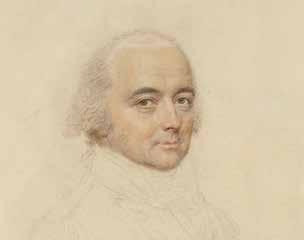
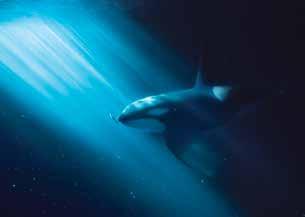
Night Snack, Audun Rikardsen, Norway. ©Audun Rikardsen/Wildlife Photographer of the Year
For carers with children 0–18 months
Seaside Strollers tours and play
12.30 pm Tuesday 19 March
Tour: Indigenous collection highlights; play: Saltwater Stories theme
April
Ocean Talks
Sharks, Humans and Jazz
6–8 pm Thursday 4 April
A lively discussion among three of Australia’s leading shark ecologists
For carers with children 0–18 months
Seaside Strollers tours and play
10.30 am or 12.30 pm Monday 8 April
Tour: Wildlife Photographer of the Year ; play: Wildlife theme
Access program
Sensory-friendly Sundays
8.30 am–11.30 am Sundays 14 and 28 April
Modified program to suit people on the autism spectrum and with a range of differing abilities
Kids and family programs
April school holidays
Sunday 14–Monday 29 April
Workshops, performances, themed creative activities and more
One-day youth photography workshop
Macro with mini beasts
10 am–5 pm Wednesday 17 April
Kids aged 8 to 14 can create their own ‘wild’ scenes with specimens, plants and insects to photograph in macro
Two-day youth workshop
Digital storytelling and film-making workshop
10 am–5 pm 23–24 April
Kids aged 8 to 14 can create and star in imaginative short narrative films inspired by the museum
Ocean Talks
Spirit of Adventure
6–8 pm Thursday 2 May
Record-setting expeditioner Justin Jones talks about what adventure has to teach us and how to nurture our adventurous spirit
For carers with children 0–18 months
Seaside Strollers tours and play
10.30 am or 12.30 pm Monday 8 April
Tour: On Sharks & Humanity ; play: Undersea theme
Family torchlight tour
Bats, rats and stowaways –HMAS Vampire
6–7.30 pm Wednesday 24 April
A dramatic after-dark tour through HMAS Vampire and Action Stations
Ocean Talks
Fastest Team on Water
6–8 pm Thursday 6 June
The challenges of trying to beat the world water speed record set more than 40 years ago
Future Ocean Talks
Thursday 4 July: NAIDOC Week – Bamal Badu (Earth and Water). Presenters Brett Leavy, Emily McDaniel, Nadeena Dixon, Shane Phillips and Beau James
Thursday 8 August: Bligh – Hero or Villain? Presenters Peter FitzSimons, Peter Briggs and Dr Stephen Gapps
Thursday 5 September: Bligh and Extreme Modern Journeys. Presenters Rob Mundle, Michelle Lee, Alex Luther and Daina Fletcher
Thursday 7 November: Hunting Prehistoric Sea Monsters. Presenter Dr Espen Knutsen Some of the Ocean Talks series are now being recorded for the ABC’s Big Ideas program and can be listened to or downloaded at abc.net.au/radionational/ programs/bigideas/
Bookings and enquiries
Booking form on reverse of mailing address sheet. Please note that booking is essential unless otherwise stated.
Book online at sea.museum/whats-on or phone 02 9298 3646 (unless otherwise indicated) or email members@sea.museum before sending form with payment. Minimum numbers may be required for an event to go ahead. All details are correct at time of publication but subject to change. Members are requested to check our website for updated and new event information.
6–8 pm Thursday 4 April
Ever wondered if shark repellent actually works, or if sharks can hear sounds under water? In this lively discussion among three of Australia’s leading shark ecologists, discover how humans and sharks interact – including findings from an experiment in which jazz music was played to Port Jackson sharks – and learn how sharks are tracked with acoustic receivers.
The guest speakers are:
Dr Catarina Vila-Pouca, who obtained her PhD at Macquarie University investigating the learning abilities of Port Jackson sharks and whether these might be affected by future ocean warming;
Associate Professor Charlie Huveneers , whose current research focuses on minimising the effects of wildlife tourism through adequate management and providing studies to support sustainable fisheries; and
Professor Culum Brown, whose main focus is comparative cognition with interests in learning and memory, cerebral lateralisation and personality of sharks.
The panel is hosted by the Maritime Museum’s Emily Jateff, Curator of Ocean Science and Technology, and presented in collaboration with the Sydney Institute of Marine Science.
Members $20, general $35. Includes light refreshments and exclusive access to the exhibition On Sharks & Humanity from 5–6 pm.
6–8 pm Thursday 2 May
Meet Justin Jones – best known for kayaking 3,000 kilometres ‘across the ditch’ from Australia to New Zealand with James Castrission in 2007. Since then, ‘Jonesy’ has made a career of undertaking epic recordsetting expeditions, including skiing to the South Pole and back and walking across the Australian outback with his one-year-old daughter.
In this gripping talk, Jonesy will take you on an emotional journey: from the desperation of being stuck in a whirlpool in the middle of the ocean, with 10-metre waves crashing all around; to the hunger as your body slowly breaks down in an unrelenting blizzard in Antarctica; and the oppressive heat of the outback as a plague of flies tests your sanity. Jonesy uses experiences from three of his major expeditions in an engaging and informative journey into what adventure has to teach us all, how we can apply it in our lives and why we need to nurture the adventurous spirit in all of us.
Hosted by the Maritime Museum’s Emily Jateff, Curator of Ocean Science and Technology.
Members $20, general $35. Includes light refreshments and, from 5–6 pm, the opportunity to view a display about the ‘Crossing the Ditch’ journey, including the expedition kayak Lot 41, in the museum’s Wharf 7 building.
6–8 pm Thursday 6 June
On 8 October 1978 Australian motorboat racer Ken Warby became the fastest man on water, travelling at 511.10 km/h in The Spirit of Australia – a boat he built in a Sydney backyard. More than 40 years later, the Warby motorsport team is back together in an attempt to go even faster. Warby’s son David is set to put his own jet boat, Spirit2 –a second-generation jet-powered hydroplane – to the test. The attempt will take place mid to late 2019 on Blowering Dam – the same stretch of water on which Ken broke both world records. David’s aim is to not only beat his father’s record, but to reach 550 km/h.
Hear from Ken, David, crew chief Philip Frawley, engineer Rob Blackadder and sponsorship manager Gordon Eckel about the challenges of getting such a huge project off the ground. Discover the history of The Spirit of Australia and how the team plan to beat the record in a few months’ time in Spirit2
Hosted by the museum’s David Payne, curator of the Australian Register of Historic Vessels. Members $20, general $35. Includes light refreshments and, from 5–6 pm, the opportunity to see Spirit of Australia just outside the museum’s theatre.
Shark researcher Associate Professor Charlie Huveneers will be one of the panellists for April’s Ocean Talk. He is involved with Project GenoJaws, a collaborative investigation of global populations of white, tiger, sand tiger (grey nurse) and mako sharks. Here he takes genetic samples from white shark jaws held in the museum’s collection. Image courtesy Sydney Institute of Marine Studies

Weekend and school holiday program
Underwater drone challenge
Sundays in March and April; daily during school holidays
Discover what’s under Sydney Harbour without getting wet! Learn to pilot an underwater drone (or remotely operated vehicle) with our staff. Show off your gaming console skills in the outdoors and challenge family and friends to see who’s the best u-drone pilot! Then at home, relive your explorations with video footage from your dives. For ages 9 and above. Suitable for wheelchair users.
Bookings essential. Session times and prices at sea.museum/drone
An underwater drone about to be sent on a mission. ANMM image
Under 5s activities
Mini Mariners Program
10–10.45 am and 11–11.45 am every Tuesday during term time and one Saturday each month
Creative free play, craft, games, dress-ups and story time in our themed activity area.
March – Around the World
April – Pirates Ahoy
May – Alphabet Animals
For ages 2–5 + carers. Members free, child $10, adult $8 (includes activities ticket). Booked playgroups welcome. Online bookings essential at sea.museum/ under5s
Kids craft and play
Kids on Deck
11 am–3 pm every Sunday during school term
Play, create and discover at Kids on Deck with art-making, interactive games and dress-ups!
Sundays in Term 1 – Imagination and the sea
Sundays in Term 2 – Go wild!
10.30 am–4 pm (hourly sessions)
Daily during school holidays
Go wild! Be inspired by underwater creatures. Craft whale puppets, print a shark tote bag or play with science experiments.
Entry included in any paid admission. Members free. No bookings required
Image James Horan Photography
Access program
Sensory-friendly Sundays
8.30 am–11.30 am Sundays 14 and 28 April
Enjoy a comfortable environment for kids and adults with a variety of sensory differences. On Sensory-friendly Sundays, our kids’ activity space and selected exhibitions will be open early for a quieter experience and modified to suit people on the autism spectrum and with a range of differing abilities. Our trained staff and volunteers will be on hand to answer any questions you have and to facilitate creative activities.
Child or adult $12. Bookings essential at sea.museum/schoolholidays

For carers with children 0–18 months Seaside Strollers tours and play
Enjoy an educator-led tour through new exhibitions, catered treats from Yots Café, and baby play time in a sensory space.
12.30 pm Tuesday 19 March –tour: Indigenous collection highlights; play: Saltwater Stories theme
10.30 am or 12.30 pm Monday 8 April –tour: Wildlife Photographer of the Year ; play: Wildlife theme
12.30 pm Tuesday 21 May –tour: On Sharks & Humanity ; play: Undersea theme
Members $15, general $20. Babies free. Includes refreshments and exhibition entry. Book at sea.museum/stroller
On Sharks & Humanity events
Sketch club, mystery tours and more
Daily to 2 June
Experience our spectacular new exhibition through interactive daily talks and tours and regular creative activities for all ages.
Or kids can explore the exhibition with creative activity trails, available every day.
Full program and bookings at sea.museum/ sharks. Fees apply for some activities. Kids’ activity trails are free with entry

Family programs – school holidays
Kids and family
Holiday activities
Sunday 14–Monday 29 April
Go wild these holidays with exhibitions, vessels, hands-on workshops, themed creative activities, performances and more. There’s an adventure to be had every day, including art-making, experiments and dressups in Kids on Deck, exploring touchable objects and artefacts at the Cabinet of Curiosities, enjoying interactive science circus performances, relaxing with a 3D film screening, and more.
Visit sea.museum/schoolholidays for full program details
Performance programs
Science Circus – Creature Feature 12.30 pm and 2 pm daily
(except Saturdays and public holidays) Sunday 14–Sunday 28 April
Enjoy spectacular science demonstrations investigating the most curious of oceandwelling creatures, marvel at daring displays of circus skill and enjoy a cast of kooky characters in this lively and interactive show. Duration 25 minutes. For ages 5–12 years.
Entry included in Big Ticket. Members free. No bookings required
Creative workshops for 8–14 years
One-day youth photography workshop
Macro with mini beasts
10 am–5 pm Wednesday 17 April
Inspired by our Wildlife Photographer of the Year exhibition, learn to create your own ‘wild’ scenes with specimens, plants and insects to photograph in macro. Take a photo shoot around the museum and build skills in using digital SLR cameras. Have your photos printed and showcased in a special exhibition.
Members $85, general $95. Bookings essential at sea.museum/youth
Cabinet of Curiosities touch trolley Ocean Commotion
11 am–12 noon and 2–3 pm daily
Sunday 14–Monday 29 April
Explore wonderful and curious scientific objects and creature specimens in this hands-on discovery device in our galleries.
Image James Horan Photography
Family torchlight tour Bats, rats and stowaways –HMAS Vampire
6–7.30 pm Wednesday 24 April
Join your character guide for a dramatic after-dark tour through HMAS Vampire and Action Stations. Enjoy creative capers, light refreshments and exclusive after-hours access to the vessel. For ages 4–12 and adults. Minimum height 90 cm.
Members: child $20, adult $15; general: child $25, adult $18. Bookings essential at sea.museum/schoolholidays
Two-day youth workshop
Digital storytelling and film-making workshop
10 am–5 pm 23–24 April
Create and star in imaginative short narrative films inspired by the museum. Learn clever techniques in scripting, performing to camera, filming and directing creative cinema. Have your finished work featured in a specialevent screening for family and friends.
Members and earlybird (until 18 April) $150; general $170. Bookings essential at sea.museum/youth
Image Nicola Walkerden
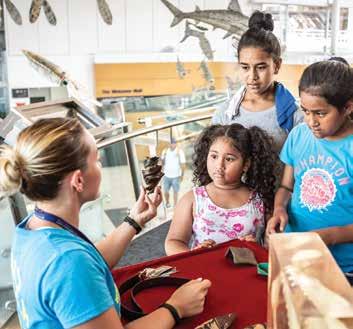

When and why did you become a member?
I joined with my family almost from the beginning. My three-year-old son and I decided to visit Darling Harbour for the first time. When we noticed the Maritime Museum we paid our entrance fee and had a look around. Liking what we saw, I invested in a family membership because we knew we would be coming back.
Do you have a nautical background?
No, but anything to do with water attracts me. We have cruised to Antarctica, the North Atlantic (Svalbard), circumnavigated the Indian Ocean and crossed the South Pacific. I am also a radio operator with Marine Rescue Sydney.
What’s your favourite aspect of museum membership?
I value the events program notifications because I do enjoy the program of talks and exhibitions. Free entry to the Fleet and exhibitions is a big bonus, and using the Members’ Lounge provides a nice break for tired feet. But I think the benefit I enjoy the most is the annual Anniversary Lunch. The wonderful speakers who entertain us, together with the delicious food and the company of other members, make this an event I try not to miss. Last but not least, Signals magazine is the best museum publication I have read. The articles are so well written and supported by facts and photos.
What sort of museum events or programs do you tend to participate in?
I like the behind-the-scenes tours and the program of talks. I wouldn’t miss the cruise during the Vivid festival, given it includes Taronga Zoo as well as the harbour lights. I have cruised up the harbour for the autumn colours and springtime jacaranda colours and I have visited just about every island and installation on the harbour. The fireworks from HMAS Vampire have been enjoyable, and I value book launches for the inside knowledge that the authors provide. I also enjoy the visiting ships, and I do not know of many other places where a tour of a submarine is available.

What have been some of your favourite exhibitions or events so far?
I enjoyed Still Life, the exhibition on Scott’s and Shackleton’s Antarctic huts. To understand how they lived was enlightening and thought provoking. The current exhibition James Cameron: Challenging the Deep is one of the best I have seen. I do enjoy Wildlife Photographer of the Year, too. The patience, fortitude and talents of these photographers are to be admired.
If you had to sum up the museum in three words, what would they be?
This is a hard question to answer – how can you describe everything the museum has to offer in three words?
‘Inclusive’ could be one word, given the Welcome Wall and the stories about people from all cultural backgrounds and every walk of life. A second word could be ‘fascinating’, given the variety and abundance of objects and vessels on display. And the third could be the self-explanatory ‘amazing’.
What else would you like to see the museum doing in the future?
My personal wish would be to be able to go out more frequently on the harbour on the vessels the museum owns. Given one of my interests, I would also like to see something that highlights the work of Marine Rescue, an organisation that exists for the benefit of sailors on all types of watercraft along the New South Wales coast and Sydney’s waterways.
Why did you join the Captain’s Circle, our new level of membership?
I joined the Captain’s Circle because I know you are a government institution and generally such places need all the help they can get. Otherwise it was entirely altruistic; I love the museum and want to see it continue in the vein in which it started, the best maritime museum it can be.
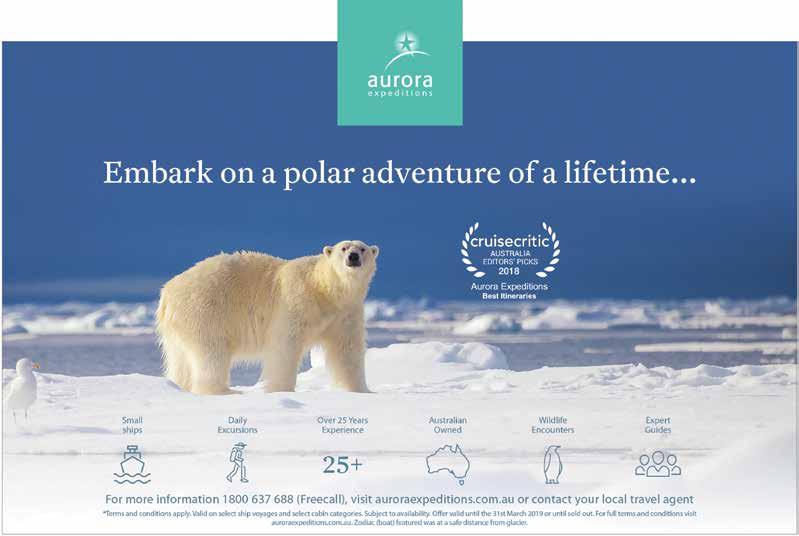

MEMBERS WILL GET TWO MAIN MEALS FOR THE PRICE OF ONE* Features a menu of modern Australian cuisine and lovely fresh seafood. This is waterfront dining at its best with stunning Sydney skyline views which includes the HMAS Onslow submarine, the HMAS Vampire destroyer & the daily buzz of this social hot spot.
*Valid Monday to Thursday at Yots Waterfront Restaurant *Available from 11.00am to 3.00pm. *No other Members Discounts apply To
Looking for Love by Tony Wu (USA). Tony wanted to capture an image that portrayed the ‘unique expression and burning desire of a male in love’. His subject was the Asian sheepshead wrasse, a fish found near Sado Island, Japan. After years of planning, and amid torrential rain, he finally found an earnest suitor for his portrait. If there are no dominant males in the school of Asian sheepshead wrasse, larger, older female wrasse will change sex. The transformed fish will use its bulbous head, which turns red in the breeding season, to gain control over other males, attracting a harem of females in the process. It will then mate with these females dozens of times a day. Image © Tony Wu/Wildlife Photographer of the Year
Displays of rarely seen animal behaviour, hidden underwater worlds and breathtaking landscapes are among the awe-inspiring images on show in this internationally renowned exhibition. Wildlife Photographer of the Year is the most prestigious photographic event of its kind, providing a global platform that has showcased the natural world’s most astonishing and challenging sights for more than 50 years.
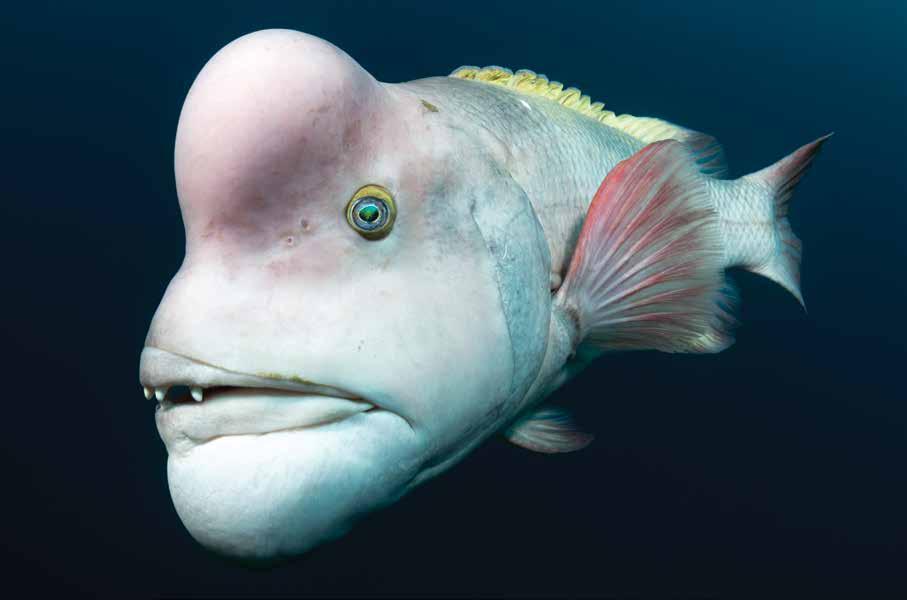
The winning images from professional and amateur photographers are selected by a panel of industry-recognised professionals for their originality, creativity and technical excellence. Through their ability to inspire curiosity and wonder, the 100 images showcase wildlife photography as an art form. They also challenge us to consider both our place in the natural world and our responsibility to protect it.
Ian Owens, Director of Science at the Natural History Museum and a member of the judging panel, says, ‘We were captivated by the outstanding quality of the images entered into this year’s competition, which spoke volumes to us about the passion for nature shared by talented photographers across the world.’
New for 2018 was the Lifetime Achievement Award, presented to acclaimed Dutch nature photographer Frans Lanting for his outstanding contribution to wildlife conservation over more than three decades. A showcase of his timeless photography features in the exhibition.
Wildlife Photographer of the Year is developed and produced by the Natural History Museum, London.
Until 2 June
A thought-provoking contemporary art exhibition about shark protection showcasing work from some of China’s leading contemporary artists.
The Sydney exhibition also features works by Aboriginal and Torres Strait Islander artists alongside photographs and artefacts from leading ocean environmentalist Valerie Taylor.
On Sharks & Humanity was conceived by Parkview Arts Action China and launched in Monaco in 2014, and has since travelled to Moscow, Beijing, Hong Kong and Singapore.
To Poseidon, Xia Hang, 2014 – one of the works that features in our current exhibition
On Sharks & Humanity. Image Samuel Carslake
James Cameron –Challenging the Deep
Until 5 May
In an exhibition that integrates two worlds of modern museums – the power of the artefact and the thrill of experience – visitors will encounter the deep-ocean discoveries, technical innovations and scientific and creative achievements of underwater explorer James Cameron. For and during his dives, he has pioneered lighting, submersible, ROV, communication and recording technologies, broken records and been the first to see and explore the least-known places on earth.
Created by the Australian National Maritime Museum’s USA Programs supported by the USA Bicentennial Gift Fund
Until 23 June
An exhibit commemorating the loss of HMAS Voyager, which collided with the aircraft carrier HMAS Melbourne on the night of 10 February 1964. Included is a model of HMAS Voyager on loan from the Naval Heritage Unit.
Image courtesy Australian War Memorial
Special 3D film screenings
11 am, 2 pm and 3 pm daily
Currently screening:
Oceans 3D: Our Blue Planet takes you on a global odyssey to discover the largest and least-explored habitat on earth.
DEEPSEA CHALLENGE 3D follows James Cameron on his record-breaking solo dive to the Challenger Deep in the Mariana Trench –at 11 kilometres down, the deepest point on our planet.
Included in any paid entry. Please check availability at sea.museum/3dcinema as sessions may occasionally be cancelled due to event bookings
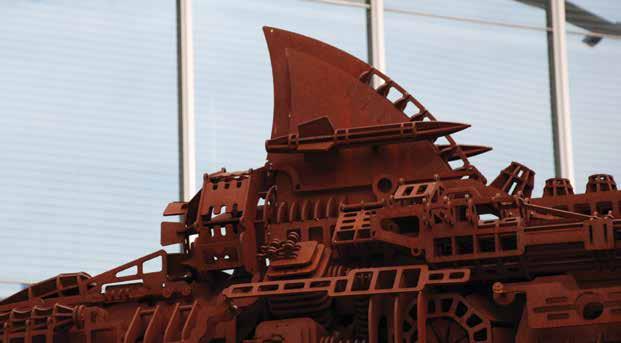
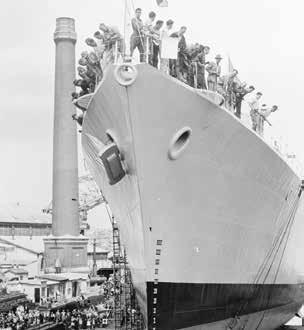
Visitor Information Centre
Tarcutta Street, Wagga Wagga NSW
Until 5 May
The museum’s first-ever outdoor exhibition is dedicated entirely to the history and impact of the humble shipping container. The exhibition goes beyond the corrugated steel to reveal the fascinating story of this revolutionary maritime invention.
Housed entirely within specially modified 20-foot containers, the exhibition quite literally takes visitors ‘inside the box’ to explore the economic, geographic, technical, environmental, social and cultural history and impact of containerisation.
Clash of the carriers: Battle of the Coral Sea panel display
Various dates and venues in Australia and the USA
Fought between combined United States and Australian naval and air forces and the Imperial Japanese Navy, this was the world’s first sea battle between aircraft carriers. Literally ‘fought in the air’, it was also the first naval battle in which opposing ships neither saw nor fired on each other. This exhibition is part of the ‘War and Peace in the Pacific 75’ program.
Created by the Australian National Maritime Museum’s USA Programs supported by the USA Bicentennial Gift Fund
Shackleton: Escape from Antarctica panel display
Various dates and venues in Australia
Through dramatic photographs taken by Australian photographers Frank Hurley and Keith Jack, Shackleton: Escape from Antarctica walks in the footsteps of these intrepid expeditioners and their team mates. Discover what happened to these brave men and their ships in the frozen Antarctic wilderness.
Submerged banner display
Various dates and venues
The Australian Maritime Museums Council (AMMC) and the Australian National Maritime Museum partnered to develop the graphic panel display Submerged: stories of Australia’s shipwrecks. Content was developed by AMMC members at maritime heritage organisations across the country, and merged into a nationally touring display by the museum. This display is supported by Visions of Australia.
Guardians of Sunda Strait panel display
Various dates and venues in Australia and the USA
On the night of 28 February–1 March 1942, HMAS Perth and USS Houston fought bravely and defiantly against overwhelming odds – outnumbered and outgunned by a large advancing Japanese naval force – as they approached Sunda Strait. Both ships sank that dreadful night in the Battle of Sunda Strait. This exhibition is part of the ‘War and Peace in the Pacific 75’ program.
Created by the Australian National Maritime Museum’s USA Programs supported by the USA Bicentennial Gift Fund
Indigenous Watercraft panel display
Various dates and venues around Australia
Since the First Fleet, 10 million people have settled in this country and made Australia home. With them have come 270 languages to join the estimated 250 Australian Indigenous languages and more than 600 dialects. Discover the different words to represent unique Indigenous watercraft specific to particular areas all around the country.
Australian Sailing Hall of Fame 2018
panel display
Various dates and venues
This graphic panel exhibition features the stories of the inaugural inductees into the Australian Sailing Hall of Fame. These greats of the sport have produced some of Australia’s most memorable sporting moments – in the America’s Cup, the Olympics, blue-water racing and world sailing. The Australian Sailing Hall of Fame touring exhibition is developed by the Australian National Maritime Museum in partnership with Australian Sailing
Homefront panel display
Various dates and venues in Australia
Banner display developed and written by students from schools in Australia, the USA and Japan. The exhibition will tour schools who have registered with our ‘War and Peace in the Pacific 75’ program, which is supported by the USA Bicentennial Gift Fund.
Banner and panel displays
There is no cost to host the travelling graphic panel displays detailed above, and the museum will arrange and pay for transport costs. For booking and enquiries please contact touringexh@sea.museum
Don’t Copy II (detail), Li Jiwei, 2015 – one of the works that features in our current exhibition On Sharks & Humanity. Image Samuel Carslake


As the 2016 census revealed, one in three Australian residents was born overseas, and of those born here, more than half have at least one parent who was born overseas. As a result, over 300 languages are spoken in our homes and 100 different religions practised. This year, the Foundation is launching the Migration Heritage Fund to strengthen support for the museum to tell stories about our migration history, writes Dr Kimberley Webber.
01
On Their Own – Britain’s child migrants toured Australia and England relating the varying stories of British children who participated in government-sanctioned child migration schemes. Image Andrew Frolows/ANMM
02
Migrants on MV Toscana photographed in Trieste, Italy, en route to Australia in 1954. ANMM Collection Gift from Barbara Alysen ANMS0214[047]
We invite Members to contribute $100 towards this fund through:
• donating on our website at sea.museum/support/donate
• by direct deposit to
Account name: Australian National Maritime Museum Foundation
BSB: 062000
Account: 1616 9309
• by contacting the Foundation Secretariat on 02 8241 8324 and donating over the phone.
All donations are tax deductible.

FOR MUCH OF OUR HISTORY, migrants have arrived by sea. The National Maritime Collection includes photographs, personal artefacts, models and even a vessel, all of which illuminate people’s experiences. A wooden fishing boat made in Vietnam in 1975–76, Tu Do (meaning Freedom) was acquired in 1990. Tan Lu, a Vietnamese store owner who had fought with the South Vietnamese during the war, built the boat and successfully navigated more than 6,000 kilometres using a map and a simple compass to bring his family and other refugees to Darwin. In 2018, Members helped the museum to acquire a rare 1929 model of the Orient Line’s SS Orontes, which brought so many British and European migrants to Australia.
A number of the museum’s most memorable exhibitions have focused on migration. In 2010 we partnered with National Museums Liverpool, UK, to tell the story of British child migration. The award-winning On their own – Britain’s child migrants explored the government-endorsed schemes that brought over 100,000 children to Australia, and was seen by more than 850,000 people on its Australian and international tour. In 2015, Coming to Australia highlighted the experiences of displaced persons migrating to Australia after World War II through a collection of photographs assembled by Australian journalist Keith Woodward, the Commonwealth representative for the Intergovernmental Committee for European Migration (ICEM) between 1957 and 1961.
Since 1991, our permanent exhibition Passengers has provided insights into people’s experience of arriving in Australia by sea, from convicts in the 18th century to refugees in the 21st. Visitors can compare shipboard life on a convict hulk with that on the 1937 ocean liner SS Orcades and, through relics of the 1857 wreck of the Dunbar, be reminded of how perilous such voyages could be. Personal mementoes and stories provide often poignant reminders of the challenges faced by those leaving families and friends behind to start again in a new country.
Recently, the museum hosted a workshop titled ‘Human Journeys in the Global Era: Migrant Cultural Heritage’. It brought together researchers from universities and collecting institutions across Australia, as well as international guests from the Huygens Institute at the Royal Netherlands Academy of Arts and Sciences, Johannes Gutenberg University Mainz, the University of Cologne and Harvard University to discuss issues relating to researching, collecting and exhibiting migration materials.
Of course, the best-known example of the museum’s commitment to honour and share our migration history is the Welcome Wall, which on 24 January 2019 celebrated the 20th anniversary of its launch by Sir William Deane AC KBE QC Since then, more than 29,000 families have registered their family’s migration journey on the wall, providing an important tribute that celebrates the diversity of Australian migrants and their journeys.
In launching the Migration Heritage Fund the museum aims to build resources to develop and support museum programs such as these. The fund will thus directly contribute to increased understanding of this rich history and promotion of a cohesive and harmonious multicultural society that enriches all our lives.
unusual new addition to the National Maritime Collection
01 Japanned papier-mâché tea tray bearing the patent mark of Henry Clay and painted with a scene of the death of Captain Cook. Image Andrew Frolows/ANMM
02
Marton Hall, home of Henry William Ferdinand Bolckow. It was already due for demolition when fire swept through it in 1960. The remains have since been demolished. Image courtesy www.lostheritage.org.uk
The death of Captain Cook may seem a bizarre scene for a tea tray, but such an item was the perfect gift for wealthy industrialist Henry Bolckow. His grand home Marton Hall was built on the site of James Cook’s birthplace, and this connection inspired Bolckow to amass one of the finest Cook collections ever assembled. By Dr Nigel Erskine .

The tray was a particularly apt gift to Henry Bolckow given his known collection and interest in Cook memorabilia

HENRY WILLIAM FERDINAND BOLCKOW (1806–1878) was born in Mecklenburg in Prussia (now northern Germany), but migrated to England in 1827. In 1841 he established the first iron foundry and rolling works in Middlesbrough, UK, in partnership with John Vaughan. Between 1827 and 1868 the population of Middlesbrough grew from less than 100 to more than 40,000, and when the town was gazetted as a municipality in 1853, Bolckow was elected its first mayor. In 1868 he was elected a Member of Parliament. His Yorkshire residence and property, Marton Hall, incorporated the birthplace of James Cook.
Living on the site of Cook’s birthplace inspired Bolckow –already a serious art collector – to assemble one of the world’s finest Cook collections. In 1868 he purchased Cook’s original manuscript journal of the Endeavour voyage as well as the Admiralty’s secret instructions. In that same year several works of art from his collection were displayed at the National Exhibition of Works of Art, Leeds, including a portrait of James Cook by John Webber, now held by the National Portrait Gallery, Canberra.
When Bolckow died in 1878 he left an estate valued at £800,000, the major part of which passed to his nephew Carl Ferdinand Henry Bolckow (1835 –1915), an ‘iron master’ himself and partner in the firm Downey and Co. Upon Carl Ferdinand’s death, the estate passed to his son, also named Henry William Ferdinand Bolckow (1865–1947).
In 1923 a small number of Cook-related objects from H W F Bolckow’s collection were sold by Sotheby, Wilkinson and Hodge. Cook’s Endeavour journal and letter book (with the Admiralty’s secret instructions) were bought by the Australian government. Now designated Manuscripts 1 and 2 (MS 1, MS 2), the journal and letter book are regarded as foundation documents of the National Library of Australia.
The tea tray is made of papier-mâché and bears an impressed patent mark of Henry Clay, a noted manufacturer of papiermâché products located at 19 Newhall Street, Birmingham. In 1772 Clay patented a method of pasting together sheets of paper over metal moulds to create a range of waterproof and heat-resistant panels used for tea trays, card and dressing tables, window shutters, coaches, mantle-pieces, tea caddies and elegant furniture. The process was known as ‘japanning’ because it produced a shiny black surface that resembled Japanese lacquerware. Clay’s patent stated that the material could be sawed, planed or turned like wood, but quite apart from its practicality and durability, many of his works were extremely elegant, notably his tea caddies, which often incorporated Wedgwood jasperware decorative medallions.
The announcement of Cook’s death was the focus of a national outpouring of grief, expressed through a variety of theatre, poetry and art
01 Death of Captain Cook by George Carter, 1781. Oil on canvas, National Library of Australia collection
02 Advertisement for Henry Clay in Bissett’s Magnificent Guide or Grand Copperplate Directory for the Town of Birmingham, 1808 03
Inscription on reverse of tea tray: ‘The Death of Captain Cook. Painted by Edward Bird R.A. Apprenticed to a tray maker of Birmingham. Born 1772, Died 1819. Presented to HWF Bolckow, Esqr. Marton Hall by John J. Bagshaw, Sheffield.’ Image Andrew Frolows/ANMM

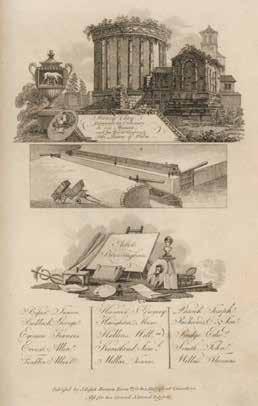

Given our knowledge of the above, the japanned tea tray by Henry Clay, with a scene of the death of Captain Cook painted by Edward Bird, after the work of artist George Carter, was produced between 1785 to 1794, probably in the latter part of that period, after Bird had honed his skills to a high level.
Clay was highly successful, employing more than 300 workers in his Birmingham factory. He obtained royal patronage after presenting a sedan-chair made of papier-mâché to Queen Caroline, allowing him to trade as ‘Japanner in Ordinary to His Majesty and His Royal Highness the Prince of Wales’. Among his many employees was artist Edward Bird (1772–1819) who, after having been apprenticed to Henry Clay at the age of 13 in 1785, moved to Bristol in 1794 to pursue his artistic career. There, he became the leader of a group of artists known as the Bristol School. He was known as an historical painter and was elected a member of the Royal Academy in 1815. It was Edward Bird who painted the death of Captain Cook on the tea tray. The scene is based on a painting (now held by the National Library of Australia) produced by artist George Carter in 1781, only months after the return of Resolution and Discovery to England in October 1780 and the announcement of Cook’s death. This was the focus of a national outpouring of grief, expressed through a variety of theatre, poetry and art. Demand was such that Carter produced a second large oil in 1783 (now held by the Bernice P Bishop Museum, Hawaii), and an engraving based on the painting in 1784.
Which brings us to John J Bagshaw, who gave the tea tray to Henry Bolckow. John James Bagshaw (or Bagshawe; 1835–1875) was born in Sheffield and established the Thames Steel Works there, manufacturing cast steel piston rods, shafts, forgings and a range of tools. He was listed in the 1867 Institute of Mechanical Engineers Proceedings as a Member since 1865.
It is unknown who owned the tray before John James Bagshaw acquired it in the mid-19th century, but the tray was a particularly apt gift to Henry Bolckow given his known collection and interest in Cook memorabilia. Bagshaw and Bolckow were both deeply involved in the iron and steel industries centred in the north of England, both shared an interest in art, and both were contributors to the National Exhibition of Works of Art held at Leeds in 1868, where one of Bolckow’s works exhibited was a portrait of Captain Cook by John Webber. In the same year, Bolckow purchased the Endeavour journal and Admiralty secret instructions.
Henry Bolckow built Marton Hall in the late 1850s. Although the inscription on the back of the tea tray is undated, given the multiple associations between the two men around 1868 and Bolckow’s newly acquired political position, it is likely that John J Bagshaw gave the tray to Henry Bolckow between 1868 and his own death in 1875.
Fundraising to assist with the purchase of this important tea tray will be the focus of our end-of-financial year campaign.
Related works
Death of Captain Cook, 1781, Oil on canvas, National Library of Australia collection
Death of Captain James Cook, 1783, Oil on canvas, Bernice P Bishop Museum, Honolulu
The Death of Captain Cook by the Indians of O,Why,ee, one of the Sandwich Islands, 1779; engraving after George Carter published by George Carter, Sayer and Bennett, London, 1784 in the collections of the National Maritime Museum, London, National Library of Australia and State Library of NSW
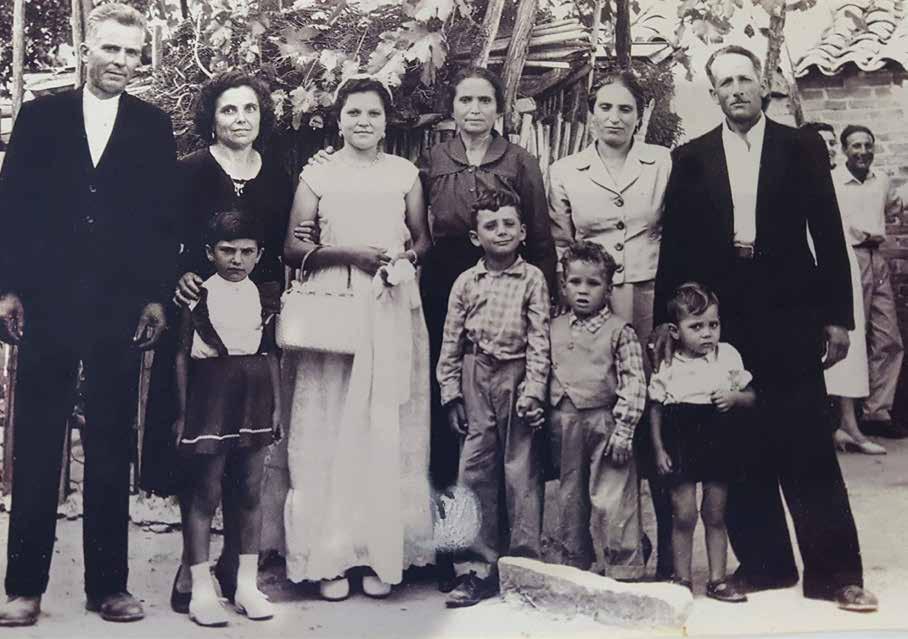
Until we meet again
An Italian proxy bride’s story
Annarosa Coluccio (née Bova) was one of 12,000 young Italian women who arrived in Australia as proxy brides between 1945 and 1976. Confronted by vast cultural and linguistic barriers, she eventually settled in with the love of her husband and the friendship of their new Australian neighbours. By curator Kim Tao.
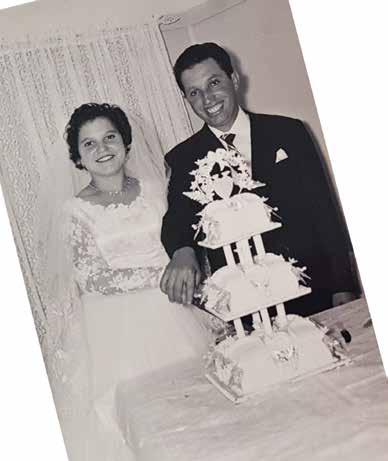
01
Annarosa Coluccio (third from left) with her parents (left) and motherin-law (fourth from left) at her proxy marriage in Roccella Jonica, Calabria, Italy, 1956. The couple on the right are Annarosa’s sister-in-law Maria and her husband Giuseppe Lo Presti, who stood in as proxy for Giuseppe Coluccio. All images reproduced courtesy Isabella Coluccio.
02
Annarosa and Giuseppe Coluccio’s wedding celebration in Australia, 1958. Annarosa is wearing the gold necklace given by her mother-in-law in Italy.
Marriage by proxy was authorised by the Catholic Church in the 16th century
IN 1956, 15-YEAR-OLD ANNAROSA BOVA accepted a proposal to marry and start a new life in Australia, some 15,000 kilometres from her Italian hometown. She was to marry by proxy Giuseppe Coluccio, an Italian immigrant who had arrived in Australia two years earlier. Wearing a gold necklace that had been given by her mother-in-law as per Italian wedding custom, Annarosa walked down the aisle of her local church to begin her new life. Due to Giuseppe’s absence, Annarosa’s brother-in-law Giuseppe Lo Presti stood in for the groom.
Marriage by proxy was authorised by the Catholic Church in the 16th century. The practice was widespread in Italy in the aftermath of the two World Wars, reaching its peak in the late 1950s. It was particularly common among the Italian community in Australia, where successive government immigration policies to recruit single men for agricultural and manufacturing work had resulted in a gender imbalance. Thus for young Italian men looking for a partner with shared cultural and family values, a proxy marriage in their homeland provided the solution. The wedding ceremony would be performed in the bridal village, with the groom represented by a substitute, or proxy, usually a brother or brother-in-law. The marriage was registered in Italy and a second celebration was often held after the bride migrated to Australia. For many young Italian women, proxy marriage and migration offered opportunity, adventure and an escape from extreme poverty.
Annarosa Bova (1940–2018) was born in the small coastal town of Roccella Jonica in the Calabria region of southern Italy. She was the fifth of seven children born to Vincenzo Bova, a contadino (farmer), and Maria Rosa Congiusta, a casalinga (housewife). The Bova family lived in a stone house in the mountains, located about an hour’s walk from the township of Roccella. The house had no electricity and only one room, in which the family slept. On their farm the family grew wheat, broad beans and olives, and raised pigs, two sheep, a goat and a donkey, which was used to transport goods and to collect water from a well. They were self-sufficient, even making their own soap from olive oil, but food was often scarce. The family endured great hardship, with the youngest son, Nicolino, dying at the age of one due to a lack of access to medical attention.
Like Annarosa, Giuseppe Coluccio (1927–2015) was born and raised in Roccella Jonica in Reggio di Calabria. He was the youngest of three siblings. When Giuseppe was two years old, his father fled to Argentina, leaving behind a wife and three children. Although there were occasional letters, Giuseppe never saw his father again. During the 1940s, Giuseppe experienced the full impact of the Second World War, economically, physically and mentally.
Seeking a better life away from the devastation of post-war Italy, Giuseppe decided to follow in the footsteps of his older brother, Natale, who had migrated to Australia in 1952. In September 1954, 26-year-old Giuseppe arrived in Sydney aboard the Flotta Lauro liner Sydney. He quickly found employment at the steelworks in Port Kembla, in the Illawarra region on the south coast of New South Wales.
In search of companionship, Giuseppe wrote to his mother back in Italy to ask for her help in finding a wife. Giuseppe was connected to Annarosa through their relatives in Roccella Jonica. Unlike some proxy marriages, where the bride and groom had only met through the exchange of photographs, it is believed that Giuseppe and Annarosa may have met at a younger age in Italy. After accepting Giuseppe’s marriage proposal, Annarosa learnt to sew, as a form of dowry and in preparation for her future role as a wife and mother. Following her proxy wedding in 1956, Annarosa lived with her mother-in-law until her migration to Australia was approved.
Like so many proxy brides, Annarosa migrated to Australia on a promise, placing her trust in family and the hope of a better future
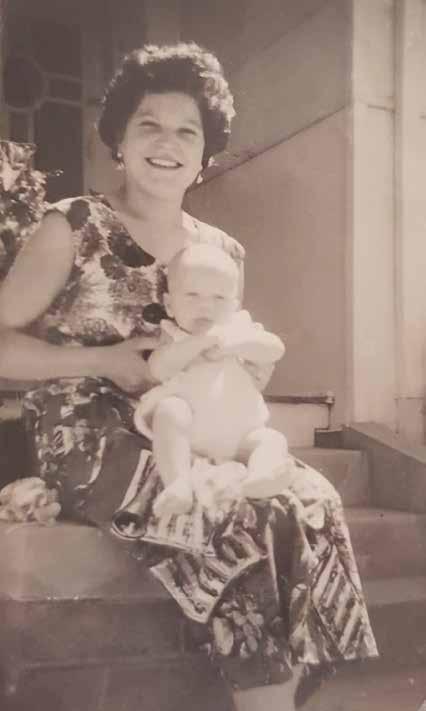
01
02
In September 1958, 17-year-old Annarosa embarked on her own from the Sicilian port of Messina on the Flotta Lauro liner Roma A young bride, she was excited at the prospect of starting a new life with Giuseppe, yet sad to be leaving her family. Like so many proxy brides, Annarosa migrated to Australia on a promise, placing her trust in family and the hope of a better future. Among her possessions were a new black coat with lace trim, as well as handwoven towels, sheets, blankets and tablecloths that had been made by her family as part of her dowry. The white linens, embroidered with the initial ‘B’ for her family name Bova, were the domestic necessities to build a new home in a new country. She also carried a photograph of Rosaria (Viola) Multari, a family friend, who would later make her own journey to Australia to marry Giuseppe’s brother, Natale.
In October 1958 Roma docked in Sydney, where Annarosa was greeted by her husband and a new neighbour. Travelling down Bulli Pass to her new home in Russell Vale, Wollongong, her first impression of Australia was that it was all bush –not dissimilar to her region of Calabria. Although she did not speak any English, Annarosa was warmly welcomed by her new neighbours, who cared for her as a daughter of their own. When Annarosa was expecting her first son Vincenzino (Vince), her neighbour Mrs Walker would take her to the clinic and ask questions on behalf of Giuseppe, who had solicited English words from his colleagues at the Port Kembla Steelworks. As time passed, Annarosa learnt English from her neighbours, her husband Giuseppe and her son Vince (born 1959), once he started school. Annarosa and Giuseppe’s two sons, Vince and Frank (born 1962), grew up speaking Italian at home prior to attending school.
In the 1970s, Annarosa took a job as a machinist at the King Gee textile factory in nearby Bellambi, to help support her family. During this period she made a return visit to Italy, followed by another visit in 1990. Since her migration in 1958, some of Annarosa’s family members have travelled to Australia.

Her mother-in-law visited in the 1960s and her eldest sister Elisabetta visited in the 2000s. Annarosa’s second eldest sister, Maria Teresa, migrated to Australia in 1961. Her brother Giuseppe also migrated in the 1960s, but returned to Italy after six years.
Annarosa was special in the hearts of many. Her story highlights the kindness of neighbours and the importance of a sense of community. Her former neighbours, the Walkers, fondly recall her connection with Mrs Walker, who would help Annarosa to prepare coddled egg for her firstborn son, Vince. Another memory is the ‘vegetable swap’ over the fence, where the two families would grow vegetables, often different, for the purpose of benefitting each other.
Like the Walkers, other former neighbours, the Grahams, warmly remember Annarosa, who introduced them to her Italian home cooking. To this day they still associate sugared almonds with her, as the sweets were served after Annarosa and Giuseppe’s Australian wedding celebration in October 1958, and again at their 50th anniversary as part of the Italian tradition of bomboniere (wedding favours). The five sugar-coated almonds symbolised health, wealth, happiness, fertility and long life.
In September 2018, Annarosa Coluccio died unexpectedly at the age of 77. She is survived by her two sons, Vince and Frank, and three grandchildren, Alexander, James and Isabella, to whom she is affectionately known as ‘Nonna’. Her courage to migrate to Australia provided her future family with many opportunities. Vince went on to complete a Diploma of Education at the Wollongong Teachers College. He was a payroll officer at the Port Kembla Steelworks and subsequently a mathematics teacher before his retirement. Frank studied a Bachelor of Science (Chemistry), worked at the Electricity Commission at Tallawarra Power Station and is now a conservationist. In 2010 Frank registered his parents Annarosa and Giuseppe Coluccio on the Welcome Wall to thank them for coming to Australia and to value their courage in moving to the other side of the world.
Vince’s daughter Isabella Coluccio reflects:
My nonna and nonno were very humble, generous people who were blessed to be accepted and befriended by their neighbours during a time when racism was prevalent. Their beliefs have helped me to further recognise the importance of education, as they had very little education due to their circumstances. Nonna’s humility has helped me to become a better person, and someone who wants to help better the lives of others. Nonna was more than gold. Her involvement in the upbringing of myself and my brothers is cherished in our hearts, and she is someone who we will forever love. The story of Annarosa and Giuseppe exemplifies the significance of face-to-face interaction and sharing with others. The generosity and kindness that they had received from their neighbours is something that our family will always hold close to our hearts.
The author wishes to thank Isabella Coluccio, Annarosa’s granddaughter, for her assistance with this article.
For 20 years, the Welcome Wall at Pyrmont Bay Wharf has celebrated and recorded the stories of those who left their native shores to make Australia home. The museum is planning a renewal of this project, with a new launch in 2020. If you wish to be informed when registrations re-open, please leave your contacts through our website: sea.museum/welcomewall
01 Kaci Cronkhite, at the helm, with her partner, Jan, sailing Pax in Port Townsend Bay. Filmed for a documentary on Pax by OffCenterHarbor.com
02 Pax during her second major haul-out – described by Kaci as ‘a haul-out from heaven compared to the first!’
I didn’t own a wooden boat and joked with friends that I ‘knew better’.
So begins a story that will resonate with anyone who has bought a wooden boat, only to find that it demands total dedication … and bottomless pockets.
A six-year veteran director of the Wooden Boat Festival at Port Townsend, in the US state of Washington, Kaci Cronkhite was well aware of the pitfalls of wooden boat ownership. But one chance sighting of a photo of Pax and she knew it was love.
The object of her affection is a 28-foot Danish-designed doubleended ‘spidsgatter’ sailboat (‘spids’ means ‘pointed’ in Danish), a class that first appeared in 1926. Pax had seen better days but, as the owner had to sell quickly, Cronkhite didn’t have time for a proper survey before she had to commit, or walk away. In the end, it was a case of ‘prepare for the worst but hope for the best’. Finding Pax is two stories: of Pax ’s restoration and of the search for her history. Cronkhite has skillfully woven the two stories together, using rich and descriptive language, and gently peeling back the layers of Pax ’s life, while at the same time chronicling the boat’s restoration. Cronkhite is candid in describing her emotional (and financial) responses to both projects – making the book intensely personal – and her engaging style makes the book a page-turner.

Finding Pax –one woman’s journey for the love of her wooden boat
By Kaci Cronkhite,published by Adlard Coles, London, 2018. Paperback, 209 pages, photographs.
ISBN 9781472958600.
RRP $30 / Members $27
Cronkhite meticulously recorded Pax ’s two stories as she went, but has distilled them into a tight but fluid account of the seven years it took to bring Pax, and her history, back to life. Appendixes provide technical specifications (including a blueprint that shows a spidsgatter’s elegant lines); a list of Pax ’s owners; details and a map of a voyage that Pax (then named Tonica) made in May and June 1937; advice on how to search for your own boat’s history; and an excellent, more detailed, explanation of the spidsgatter class.
Following leads, and travelling far and wide, rewarded Cronkhite with a near-complete history of Pax, making her many friends along the way, although a missing period from 1961 to 1974 must be frustrating. Perhaps, as she hopes, this book may help fill that gap once word gets around in boatie circles.
There are a few photographs in the main text that would have benefited from being printed on better quality paper, but a section of mostly colour photos is on high-quality photographic paper and these are very clear – even to showing the Australian National Maritime Museum’s logo on a bag in Pax ’s cabin! I would have liked to see a plan of Pax ’s interior layout to see how she was adapted to her current use, but that is a minor quibble in an otherwise excellent selection of images.
This story of Pax ’s literal and metaphorical journey delivers in spades, and will appeal to boaties and history buffs alike.
Reviewer Randi Svensen is a maritime writer and author of Wooden Boats, Iron Men: the Halvorsen story (2004) and Heroic, Forceful and Fearless: Australia’s tugboat heritage (2011).
‘I didn’t own a wooden boat and joked with friends that “I knew better”’
– Kaci Cronkhite



ON 19 OCTOBER 2018 the museum partnered with Australian Sailing to announce the second round of honourees in the Australian Sailing Hall of Fame, a program developed by both organisations to acknowledge the depth and breadth of Australian sailing from the sport’s first days in the early 1800s to today.
Four-time Olympian Alexander ‘Jock’ Sturrock mbe (1915–1997) is among the honourees. He was an Australian Olympic sailing pioneer who competed overseas from the late 1930s, opening up that world to Australian sailors. He also won many world, Australian and state championships. In 1962 he skippered America’s Cup challenger Gretel to take a race from the Americans, the first time a challenger had done so since 1934.
In the same year he was recognised as the inaugural Australian Yachtsman of the Year, Australian Sportsman of the Year and Australian of the Year.
Elder statesman of ocean racing Syd Fischer am obe (born 1927) is highly respected for nurturing talent in sailors who continue to dominate the world sailing scene today, including America’s Cup skipper Jimmy Spithill. Fischer’s boats, including Ragamuffin and Steak’n’Kidney (rhyming slang for his home city, Sydney) were widely recognised in a career that spanned 47 Sydney–Hobart yacht races, an Admiral’s Cup win, a One Ton Cup world championship, five America’s Cup challenges and induction into the America’s Cup Hall of Fame in 2017.
Host Gordon Bray am with 2018 Australian Sailing Hall of Fame honourees and family members at the awards event. From left: John Anderson oam, Brenton Fischer, Tony Ellis, Gordon Bray, Sylvia Cuneo, Jon Sanders ao obe cit wa , Christopher Tyquin, Brad Anderson, Virginia Jamieson, Samuel Jamieson. Image courtesy Australian Sailing
The 2018 inductees included two teams who won gold medals at the 1972 Munich Olympic Games on the waters at Kiel, among them a set of twins: Star class sailors David Forbes OAM and John Anderson OAM and Dragon class sailors John Cuneo OAM , Thomas Anderson and John Shaw. Both wins inspired a generation of Olympic sailors.
Round-the-world sailor and adventurer Jon Sanders AO OBE CitWA has made ten circumnavigations and set numerous world records, including the longest distance ever sailed continuously by any vessel unassisted and solo. More at home on the sea than on land, Sanders completed his latest circumnavigation in 2018 at the age of 78.
This latest group joins the America’s Cup Australia II team, solo round-theworld sailor Kay Cottee AO, Olympic sailing coach Victor Kovalenko OAM , paralympians Daniel Fitzgibbon OAM and Liesl Tesch AM and other esteemed inductees from the launch of the Australian Sailing Hall of Fame in 2017.
The website sailinghalloffame.org.au features the stories of each inductee, individual or team that has striven to be at the top of their sport. They are as much inspirational personal journeys as they are sporting stories.
Please visit the website to nominate for this year’s round of inductees, who will be announced on 18 October.
Daina Fletcher, Senior Curator
Join us at the MuseumNext conference, 1 and 2 April
IF YOU HAVE BEEN FOLLOWING the last few issues of Signals, you will have seen that the museum has become increasingly involved in hosting conferences – not just as a hired venue but as an active participant (though if you would like to hold a conference here, we’d love to hear from you!). In the last two years we have been the venue for major conferences on Indigenous watercraft and the Archaeology of War, both core topics in the museum’s research and education programs.
In 2019 we will be the venue for two major conferences about the practice and challenges of being a museum in the 21st century. The first, MuseumNext, is coming up in April. This international conference series has been running since 2009 and is very much focused on the future of our sector.
Like any organisation, museums must evolve and adapt to a changing environment, while also maintaining the continuity of our collections and our connections to history and heritage. Different generations of our audiences bring new perspectives and expectations of what a day out at a cultural site should entail, the technologies of display and interaction are in constant flux, and we must compete in an increasingly busy environment for attention, visitors and funding.
With these challenges come amazing opportunities – with museums all over the world finding innovative and unexpected solutions and creating new research, collections and public programs.
This sector is very collaborative and open to sharing ideas, and MuseumNext promotes this by bringing together museum workers from all over the world to collectively focus on where our field is going and to share their most recent work. Its focus is not academic; rather, it skews strongly towards problemsolving and innovation. This approach is one that is interesting and accessible to people in a wide range of museum sector roles or who have a keen interest in the relationships between people, technology and culture.
Hosting MuseumNext in 2019, at a time when the museum is evolving its brand and public programs, is a great opportunity for us to reflect on what we are doing and how we will evolve into the future. The theme of the conference is ‘Play in Museums’, a topic that will challenge us all to think about how we are creating truly engaging and memorable experiences for visitors of all ages by inviting them to actively participate and to see us as places of enjoyment and creativity.
If you are interested in attending the conference, or in exploring how the museum sector works from insiders’ perspectives, you can register or view previous MuseumNext conference presentations at museumnext.com.
Michael Harvey, Assistant Director Public Engagement and Research
The Australian National Maritime Museum acknowledges the support provided to the museum by all our volunteers, members, sponsors, donors and friends.
The museum particularly acknowledges the following people who have made a significant contribution to the museum in an enduring way or who have made or facilitated significant benefaction to it.
Honorary Fellows
RADM Andrew Robertson
AO DSC RAN (Rtd)
John Mullen
Ambassador Christine Sadler
Honorary Life Members
Dr Kathy Abbass
Robert Albert AO RFD RD
Bob Allan
Vivian Balmer
Vice Admiral Tim Barrett
AO CSC
Maria Bentley
Mark Bethwaite AM
Paul Binsted
Marcus Blackmore AM
John Blanchfield
Alex Books
Ian Bowie
Ron Brown OAM
Paul Bruce
Anthony Buckley
Richard Bunting
Capt Richard Burgess AM
Kevin Byrne
Cecilia Caffrey
Sue Calwell
RADM David Campbell AM
Marion Carter
Victor Chiang
Robert Clifford AO
Helen Clift
Hon Peter Collins AM QC
John Coombs
Kay Cottee AO
Helen Coulson OAM
Vice Admiral Russell Crane
AO CSM
John Cunneen
Laurie Dilks
Anthony Duignan
Leonard Ely
Kevin Fewster AM
Bernard Flack
Daina Fletcher
Sally Fletcher
CDR Geoff Geraghty AM
Tony Gibbs
RADM Stephen Gilmore
AM CSC RAN
Paul Gorrick
Lee Graham
Macklan Gridley
Sir James Hardy KBE OBE
RADM Simon Harrington AM
Gaye Hart AM
Peter Harvie
Janita Hercus
Robyn Holt
William Hopkins
Julia Horne
RADM Tony Hunt AO
Marilyn Jenner
John Jeremy AM
Vice Admiral Peter Jones
AO DSC
Hon Dr Tricia Kavanagh
John Keelty
Ian Kiernan AO
Kris Klugman OAM
Jean Lane
Judy Lee
Keith Leleu OAM
Andrew Lishmund
James Litten
Tim Lloyd
Ian Mackinder
Casimiro Mattea
Jack McBurney
Bruce McDonald AM
Lyn McHale
Arthur Moss
Patrick Moss
Rob Mundle OAM
Alwyn Murray
Martin Nakata
David O’Connor
Gary Paquet
Prof John Penrose AM
Neville Perry
Hon Justice Anthe Philippides
Peter Pigott AM
Len Price
RADM Neil Ralph AO DSC
Eda Ritchie AM
RADM Andrew Robertson
AO DSC RAN (Ret)
John Rothwell AO
Kay Saunders AM
Kevin Scarce AC CSC RAN
David Scott-Smith
Sergio Sergi
Mervyn Sheehan
Ann Sherry AO
John Simpson
Shane Simpson AM
Peter R Sinclair AC KStJ (RADM)
Peter John Sinclair AM CSC
John Singleton AM
Brian Skingsley
Eva Skira
Bruce Stannard AM
J J Stephens OAM
Michael Stevens
Neville Stevens AO
Dr Andrew Sutherland AM
Hiroshi Tachibana
Frank Talbot AM
Mitchell Turner
Adam Watson
Jeanette Wheildon
Mary-Louise Williams AM
Nerolie Withnall
Founding Members
Chad Bull
Janette Biber
Bruce Webster
Margaret Molloy
Kaye Weaver
David Leigh
Yvonne Abadee
Maria Tzannes
George Fehrenbach
Derek Freeman
Alan Stennett
Rob Hall
Ivor MacDonald
Nancy Somerville
Ross Wilson
Marcia Bass
Christopher Harry
Malcolm Horsfall
Virginia Noel
Dennis Rose
John Lynch
Barry Pemberton
John Butler
Judy Bayles
Allaster McDougall
Sybil Jack-Unger
Richard Newton
James Downie
Glenn and Sue Yates
Neville Sully
John Seymour
Peter Magraith
Judy Finlason
Cliff Emerson
David Toyne
Kenneth Grundy
Geoff Tonkin
David Voce
David Waghorn and
Helen Nickson
Vincent Favaloro
Colin Randall
Denise Taylor
Joan and Robert Killingsworth
Ian Peters
Robert Heussler
Dean Claflin
Harry Wark
John Hamilton
Kenneth Swan
Mark Latchford
James Hawkins
Ross and Valda Muller
Joyce Groves
Lyndyl Beard
Walter Pywell
John and Marlene Vaughan
Peter Wilson
Angela and Teresa
Giannandrea
Fairlie Clifton
Richard and Margaret
McMillan
Timothy Lewis
Maxwell Beever
Paul Joyce
Petra Blumkaitis and Paul Wahltuch
David Robinson
Paul Cavanagh
Robert and Mary Dick
Michael Stacey
Peter and Jan Scutts
Peter Rowse
John Hoey
Ronald McJannett
John Swanson
Herbert White
John O’Toole
Robert Newell
Tim and Kathe Swales
Peter Harvey
Andrew Kerr
Ronald and Toni White
Michael Connor
Len Watson
Pamela Lowbridge
John Carter
Paul Richardson
Peter O’Hare
Stephen Dowsett
Simon Barker
Bruce Watson
Steven White
John Bach
Bill and Eugenie Forbes
Geoffrey Winter
Michael and Evelina O’Leary
Colin Delaney
Mitchell White and Suzanne Peel
Adrian Lane
Halcyon Evans
Bill Fenwick
Stephen Smith
David Cunningham
Peter Inchbold
Jean Morgan
John Egan
Barry Allison
Walter Bateman
Peter Siebert
Michael Turner
Stuart Ridland
David Nutley
Anthony and Katy Palmer
Mark Johnson and Lyn Ashby
James Littlefield
Hilda Farquhar-Smith
Robert Holman
Bruce Small
Garry Kerr
William Bixley
Derrick Heywood
Peter Anderson
Neville Rothfield
John Brock
Graeme Broxam
Fred Cory
Michael Dowsett
Maxwell Surman-Smith
Campbell Edmondson
Paul Lincoln
Tempe Merewether
Sydney Jones
Stephanie Ross
Robert Murphy
Derek Moore
Anne Liddy
Nigel Stoke
Alan Ward
Philip and Jennifer Andrew
Peter Cramer
Jeffery Coleman and Lindsey Marwood
Allan Bridekirk
Bruce and Robyn Tolhurst
Chris Clark
John and Cecily Ristuccia
Andrew Johnston
Phillip Good
Dawn Springett
Greg Swinden
Ron and Helen Scobie
Edwina Gowans
Murray Doyle
Adrian and Glenda Hutchings
Peter Gill
Ian Robinson
Trevor Thomas
Jeffrey Mellefont
Neville Marshall
Bob Walton
Peter Bailey
Andrew St John-Brown
Ann Parry
Gary Wilson
Kevin Murphy
Richard and Christine Diaz
Robert and Lynette
Schaverien
Richard Gardner
Rosemary Mahon
Daniel and Rosemary Howard
Lindsay Rex
Valerie Packer
Angus Caporn
Tom Fawcett
Patrick Cooney and Madeleine Degnam
Craig Webb
William Abbott
Neil Brough
Susan Tompkins
Michael Wise
Ann Campbell
Ken Woolfe
Sarah Marang
Chris Mitchell
Rob Landis
Lloyd Seaforth Poulton and Joan Poulton
Margaret White AO
Maxwell Bryan
Peter Campbell
Peter Cumes
Len & Marion Graff
Alan Brown
Gregory MacMahon
Cheryl Manns and
Robert Scott
Vicky Bourne
John Inglis OAM
Kenneth Edwards
Stephen Robinson
Margaret Arthur
John Clifton
Johan Brinch
John Duncan
Garry and Janice Sherwood
Julie Armour
Dawn and Ron Bradner
Alexander Bradner
Owen Summers
Warwick Birrell
Jack McBurney
Brian and Judith Skingsley
Marcus Blackmore AM
Anthony Duignan
Helen Kenny
Marion Carter
Therese Van Kints
Honorary Research
Associates
Lindsey Shaw
Jeffrey Mellefont
Paul Hundley
Rear Admiral Peter Briggs
Ian MacLeod





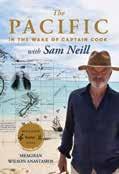
Shark – Eyewitness Guide
How do sharks detect their prey? Why do they attack humans? This book features vivid images of various shark species and informative text about shark artefacts, behaviour and biology.
$22.00 / Members $19.80
On Sharks & Humanity catalogue
Catalogue to accompany the museum’s current exhibition of thought-provoking contemporary artworks about shark protection from some of China’s leading contemporary artists.
$20.00 / Members $18.00
Ocean Bingo
Family-friendly game packed with ocean creatures: emperor penguin, sea otter, killer whale, Pacific seahorse and more.
$39.95 / Members $35.96
Glass shark
Hand-blown grey glass shark ornament, 20 x 12.5 x 13 cm.
$49.95 / Members 44.95
Limit pilot watch
Inspired by the design of aircraft navigation instruments. Face 4 cm diameter; day/date function.
$89.95 / Members $80.95
The Pacific
Companion book to the Foxtel documentary series. Actor Sam Neill takes a deeply personal journey to map his own understanding of James Cook and the immense Pacific Ocean itself.
$45.00 / Members $40.50


Or shop online at
Captain Cook and the Pacific Cook’s Pacific voyages illustrated through the collections of Britain’s National Maritime Museum: paintings, scientific and navigational instruments, ship plans, globes, charts and maps, rare books and manuscripts, personal effects and more.
$79.95 / Members $71.95
Pacific Exploration
Reveals the European voyages that continued Cook’s work of both charting the Pacific, and starting to exploit and control it. Examines those who came after Cook – including Bligh, Vancouver, Flinders, Lapérouse and Phillip – and the period that saw Britain become the world’s leading maritime power.
$35.00 / Members $31.50
Signals
ISSN 1033-4688
Editor Janine Flew
Staff photographer Andrew Frolows
Design & production Austen Kaupe
Printed in Australia by Pegasus Print Group
Material from Signals may be reproduced, but only with the editor’s permission.
Editorial and advertising enquiries
signals@sea.museum
Deadline mid-January, April, July, October for issues March, June, September, December
Signals is online
Search all issues at sea.museum/signals
Signals back issues
Back issues $4 each or 10 for $30
Extra copies of current issue $4.95
Call The Store 02 9298 3698
Australian National Maritime Museum
Open daily except Christmas Day 9.30 am to 5 pm (6 pm in January)
2 Murray Street Sydney NSW 2000 Australia. Phone 02 9298 3777
The Australian National Maritime Museum is a statutory authority of the Australian Government
Become a museum Member
Benefits include four issues of Signals per year; free museum entry; discounts on events and purchases; and more.
Visit sea.museum or phone 02 9298 3646. Corporate memberships also available.
@seamuseum_
/anmmuseum
#seamuseum
sea.museum/blog

ANMM Council
Chairman Mr Peter Dexter AM FAICD
Director and CEO Mr Kevin Sumption PSM
Councillors
Mr David Blackley
The Hon Ian Campbell
Hon Justice S C Derrington
Ms Maria Teresia Fors
Rear Admiral Jonathan Mead AM RAN
Mr John Mullen
Ms Alison Page
The Hon Margaret White AO
Ms Arlene Tansey
American Friends of the Australian National Maritime Museum
Chair Peter Collins AM QC
Director Robert Moore
Foundation partner
ANZ
Major partners
Nine Entertainment
NSW Ports

Congratulations to Hayley Walton, who won the Signals 125 caption competition with this entry: ‘I know the Captain requested fireworks for the Admiral’s birthday, but isn’t this a bit over the top?’

Partners
ACFS Port Logistics
AMSA
Aurora Expeditions
Colin Biggers & Paisley
Commonwealth Superannuation
Corporation
Confucius Institute
Cultural Foundation Ekaterina
Destination NSW
Douglas Fabian Productions
DP World
Foxtel History Channel
Gordon Darling Foundation
Hong Kong Maritime Museum
Laissez-Faire Catering
Maritime Container Services
Musée Océanographique de Monaco
National Geographic
National Museum of China
NITV
Parkview Museum
Royal Wolf Holdings Ltd
Shipping Australia Limited
Smit Lamnalco
Sydney by Sail Pty Ltd
Sydney Morning Herald
Torch Media
Total E & P
Transport for NSW
UNSW
White Umbrella
Wildaid
Signals is printed in Australia on Hannoart Plus Silk 250 gsm (cover) and Hannoart Plus Silk 115gsm (text) using vegetable-based inks.

If you’re a veteran or serving member of the Australian Defence Force entry to the Museum is on us
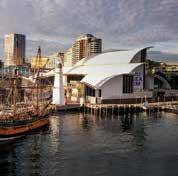
Commonwealth Superannuation Corporation (CSC) has a long history of serving members of the Australian Defence Force.
We greatly value and appreciate the commitment and loyal service of our veterans, serving members of the Army, Navy and Air Force, and cadets.
As a way of saying thanks, CSC is providing every single Defence Force veteran, serving member and current cadet with a complimentary pass to the Australian National Maritime Museum.
If you’re a Defence Force veteran, a serving member, or a current cadet just show the Museum’s front of house team your valid ADF ID card, a DVA-issued card, service medals, or arrive in uniform and you’ll receive free entry to the Museum.
csc.gov.au
CSC – the experts in superannuation for Australian Government employees and ADF members
